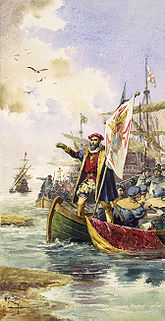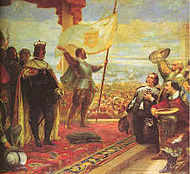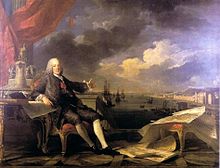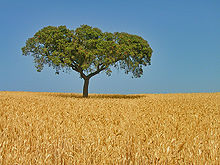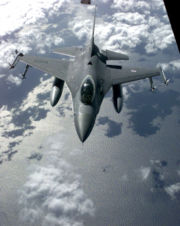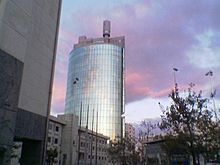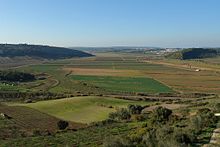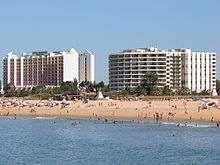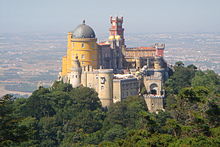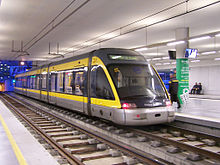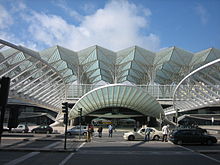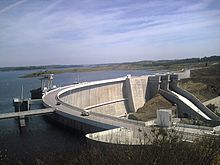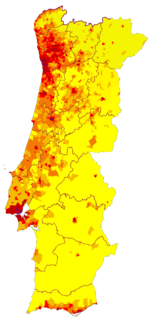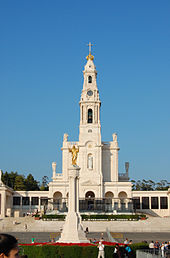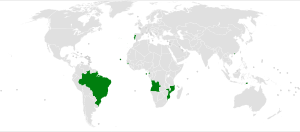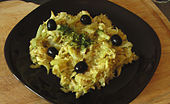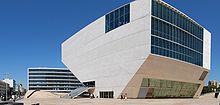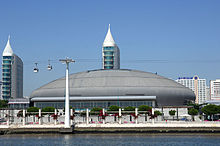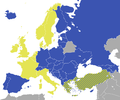- Portugal
-
This article is about the country. For other uses, see Portugal (disambiguation).
Portuguese Republic República Portuguesa (Portuguese)

Flag Coat of arms Anthem: "A Portuguesa"
"The Portuguese Anthem"
Location of Portugal (dark green)– in Europe (green & dark grey)
– in the European Union (green) — [Legend]Capital
(and largest city)Lisbon
38°46′N 9°9′W / 38.767°N 9.15°WOfficial language(s) Portuguese Recognised regional languages Mirandese1 Ethnic groups (2007) 96.87% Portuguese and 3.13% other ethnicities (Cape Verdeans, Brazilians, Ukrainians, Goans, Angolans, etc.)[1] Demonym Portuguese Government Unitary parliamentary republic - President Aníbal Cavaco Silva (PSD) - Prime Minister Pedro Passos Coelho (PSD) - Assembly President Assunção Esteves (PSD) Formation Conventional date for Independence is 1139 - Founding 868 - Re-founding 1095 - De facto sovereignty 24 June 1128 - Kingdom 25 July 1139 - Recognized 5 October 1143 - Papal Recognition 23 May 1179 - Restoration of independence 1 December 1640 - Restoration of independence recognized 13 February 1668 - Republic 5 October 1910 - Democracy 25 April 1974 Area - Total 92,090 km2 (110th)
35,645 sq mi- Water (%) 0.5 Population - 2011 estimate 10,647,763[2] (77th) - 2011 census 10,555,853[3] - Density 115/km2 (96th)
298/sq miGDP (PPP) 2010 estimate - Total $247.037 billion[4] (48th) - Per capita $23,222[4] (39th) GDP (nominal) 2010 estimate - Total $229.336 billion[4] (37th) - Per capita $21,558[4] (32nd) Gini (2009) 33.7[5] HDI (2011)  0.809[6] (very high) (41st)
0.809[6] (very high) (41st)Currency Euro (€)2 ( EUR)Time zone WET (UTC+0) - Summer (DST) WEST (UTC+1) Date formats dd-mm-yyyy, yyyy-mm-dd, yyyy/mm/dd Drives on the right ISO 3166 code PT Internet TLD .pt Calling code 351 1 Mirandese, spoken in some villages of the municipality of Miranda do Douro, was officially recognized in 1999 (Lei n.° 7/99 de 29 de Janeiro), since then awarding an official right-of-use Mirandese to the linguistic minority it is concerned.[7] The Portuguese Sign Language is also recognized. 2 Before 1999: Portuguese escudo. Portugal
 i/ˈpɔrtʃʉɡəl/ (Portuguese: Portugal, IPA: [puɾtuˈɣaɫ]), officially the Portuguese Republic (Portuguese: República Portuguesa) is a country situated in southwestern Europe on the Iberian Peninsula. Portugal is the westernmost country of Europe, and is bordered by the Atlantic Ocean to the West and South and by Spain to the North and East. The Atlantic archipelagos of the Azores and Madeira are part of Portugal. The country is named after its second largest city, Porto, whose Latin name was Portus Cale.[8]
i/ˈpɔrtʃʉɡəl/ (Portuguese: Portugal, IPA: [puɾtuˈɣaɫ]), officially the Portuguese Republic (Portuguese: República Portuguesa) is a country situated in southwestern Europe on the Iberian Peninsula. Portugal is the westernmost country of Europe, and is bordered by the Atlantic Ocean to the West and South and by Spain to the North and East. The Atlantic archipelagos of the Azores and Madeira are part of Portugal. The country is named after its second largest city, Porto, whose Latin name was Portus Cale.[8]The land within the borders of today's Portuguese Republic has been continuously settled since prehistoric times: occupied by Celts like the Gallaeci and the Lusitanians, integrated into the Roman Republic and later settled by Germanic peoples such as the Suebi and the Visigoths, in the 8th century the lands were conquered by Moors. During the Christian Reconquista, Portugal established itself as an independent kingdom from León, claiming to be the oldest European nation-state.[9]
In the 15th and 16th centuries, as the result of pioneering the Age of Discovery, Portugal expanded western influence and established a global empire that included possessions in Africa, Asia, Oceania, and South America, becoming one of the world's major economic, political and military powers. The Portuguese Empire was the first global empire in history,[10] and also the longest lived of the European colonial empires, spanning almost 600 years, from the capture of Ceuta in 1415, to the handover of Macau to China in 1999. However, the country's international status was greatly reduced during the 19th century, especially following the independence of Brazil, its largest colony.
After the 1910 revolution deposed the monarchy, the democratic but unstable Portuguese First Republic was established being then superseded by the "Estado Novo" authoritarian regime. Democracy was restored after the Portuguese Colonial War and the Carnation Revolution in 1974, after which Portugal's last overseas provinces became independent (most prominently Angola and Mozambique); the last overseas territory, Macau, was ceded to China in 1999.
Portugal is a developed country with an advanced and high-income economy, with a very high Human Development Index. It has the world's 19th-highest quality-of-life, one of the top health care systems, and it's also one of the world's most globalized and peaceful nations.[11] A member of the European Union and the United Nations, it is as well a founding member of the Latin Union, the Organization of Ibero-American States, OECD, NATO, Community of Portuguese Language Countries, the Eurozone and the Schengen Agreement.
Contents
History
Early history
Main articles: Lusitania, Visigothic Kingdom, Suebic Kingdom of Galicia, and Umayyad conquest of HispaniaThe early history of Portugal is shared with the rest of the Iberian Peninsula. The name of Portugal derives from the Roman name Portus Cale. The region was settled by Pre-Celts and Celts, giving origin to peoples like the Gallaeci, Lusitanians, Celtici and Cynetes, visited by Phoenicians and Carthaginians, incorporated in the Roman Republic dominions as Lusitania and part of Gallaecia (both part of Hispania), after 45 BC until 298 AD, settled again by Suebi, Buri, and Visigoths, and conquered by Moors. Other minor influences include some 5th century vestiges of Alan settlement, which were found in Alenquer, Coimbra and even Lisbon.[12]
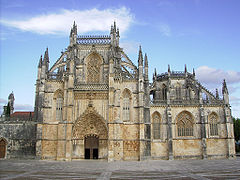 The Batalha Monastery, built in 1385, is one of the best and original examples of Late Gothic architecture in Portugal. It is also a UNESCO World Heritage Site.
The Batalha Monastery, built in 1385, is one of the best and original examples of Late Gothic architecture in Portugal. It is also a UNESCO World Heritage Site.
Reconquista
Main articles: Kingdom of Galicia, County of Coimbra, County of Portugal, Battle of São Mamede, and Kingdom of PortugalDuring the Reconquista period, Christians reconquered the Iberian Peninsula from the Muslim and Moorish domination. In 868, the First County of Portugal was formed. A victory over the Muslims at Battle of Ourique in 1139 is traditionally taken as the occasion when the County of Portugal as a fief of the Kingdom of León was transformed into the independent Kingdom of Portugal.
Henry, to whom the newly formed county was awarded by Alfonso VI for his role in reconquering land from the Moors, based his newly formed county in Bracara Augusta (nowadays Braga), capital city of the ancient Roman province, and also previous capital of several kingdoms over the first millennia.
On 24 June 1128, the Battle of São Mamede occurred near Guimarães. Afonso Henriques, Count of Portugal, defeated his mother Countess Teresa and her lover Fernão Peres de Trava, thereby establishing himself as sole leader. Afonso Henriques officially declared Portugal's independence when he proclaimed himself king of Portugal on 25 July 1139, after the Battle of Ourique. He was recognized as such in 1143 by Alfonso VII, king of León and Castile, and in 1179 by Pope Alexander III.
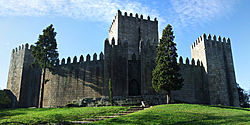 The Castle of Guimarães, Guimarães – the city is known as the cradle of Portugal.
The Castle of Guimarães, Guimarães – the city is known as the cradle of Portugal.
Afonso Henriques and his successors, aided by military monastic orders, pushed southward to drive out the Moors, as the size of Portugal covered about half of its present area. In 1249, this Reconquista ended with the capture of the Algarve on the southern coast, giving Portugal its present-day borders, with minor exceptions.
In 1348 and 1349, like the rest of Europe, Portugal was devastated by the Black Death.[13]
In 1373, Portugal made an alliance with England, which is the longest-standing alliance in the world.
In 1383, the king of Castile, husband of the daughter of the Portuguese king who had died without a male heir, claimed his throne. An ensuing popular revolt led to the 1383-1385 Crisis. A faction of petty noblemen and commoners, led by John of Aviz (later John I), seconded by General Nuno Álvares Pereira defeated the Castilians in the Battle of Aljubarrota. This celebrated battle is still a symbol of glory and the struggle for independence from neighboring Spain.
Exploration, colonization and trade
Main article: History of Portugal (1415–1542)In the following decades, Portugal spearheaded the exploration of the world and undertook the Age of Discovery. Infante Dom Henry the Navigator, son of King João I, became the main sponsor and patron of this endeavor.
In 1415, Portugal conquered the first of its overseas colonies by conquering Ceuta. It was the first prosperous Islamic trade center in North Africa. There followed the first discoveries in the Atlantic: Madeira and the Azores, which led to the first colonization movements.
Throughout the 15th century, Portuguese explorers sailed the coast of Africa, establishing trading posts for several common types of tradable commodities at the time, ranging from gold to slaves, as they looked for a route to India and its spices, which were coveted in Europe.
The Treaty of Tordesillas, intended to resolve the dispute that had been created following the return of Christopher Columbus, was signed on 7 June 1494, and divided the newly discovered lands outside Europe between Portugal and Spain along a meridian 370 leagues west of the Cape Verde islands (off the west coast of Africa).
In 1498, Vasco da Gama finally reached India and brought economic prosperity to Portugal and its population of 1.7 million residents.
In 1500, Pedro Álvares Cabral discovered Brazil and claimed it for Portugal.[14] Ten years later, Afonso de Albuquerque conquered Goa, in India, Ormuz in the Persian Strait, and Malacca, now a state in Malaysia. Thus, the Portuguese empire held dominion over commerce in the Indian Ocean and South Atlantic. The Portuguese sailors set out to reach Eastern Asia by sailing eastward from Europe landing in such places as Taiwan, Japan, the island of Timor, and may have been the first Europeans to discover Australia and even New Zealand.[15]
The Treaty of Zaragoza, signed on 22 April 1529 between Portugal and Spain, specified the antimeridian to the line of demarcation specified in the Treaty of Tordesillas. All these facts made Portugal the world's major economic, military, and political power from the 15th century to the beginning of the 16th century.
Iberian Union and Restoration
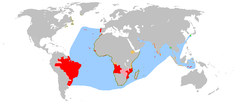 An anachronistic map of the Portuguese Empire (1415–1999). Red – actual possessions; Olive – explorations; Orange – areas of influence and trade; Pink – claims of sovereignty; Green – trading posts; Blue – main sea explorations, routes and areas of influence. The disputed Portuguese discovery of Australia is not shown.
An anachronistic map of the Portuguese Empire (1415–1999). Red – actual possessions; Olive – explorations; Orange – areas of influence and trade; Pink – claims of sovereignty; Green – trading posts; Blue – main sea explorations, routes and areas of influence. The disputed Portuguese discovery of Australia is not shown.
Portugal's independence was interrupted between 1580 and 1640. This occurred because the last two kings of the House of Aviz – King Sebastian, who died in the battle of Alcácer Quibir in Morocco, and his great-uncle and successor, King Henry of Portugal – both died without heirs, resulting in the extinction of that royal house. Subsequently, Philip II of Spain claimed the throne and so became Philip I of Portugal. Although Portugal did not lose its formal independence, it was governed by the same monarch who governed Spain, briefly forming a union of kingdoms, as a personal union. The joining of the two crowns deprived Portugal of a separate foreign policy, and led to the involvement in the Eighty Years' War being fought in Europe at the time between Spain and the Netherlands. War led to a deterioration of the relations with Portugal's oldest ally, England, and the loss of Hormuz. From 1595 to 1663 the Dutch-Portuguese War primarily involved the Dutch companies invading many Portuguese colonies and commercial interests in Brazil, Africa, India and the Far East, resulting in the loss of the Portuguese Indian Sea trade monopoly.
In 1640, John IV spearheaded an uprising backed by disgruntled nobles and was proclaimed king. The Portuguese Restoration War between Portugal and Spain on the aftermath of the 1640 revolt, ended the sixty-year period of the Iberian Union under the House of Habsburg. This was the beginning of the House of Braganza, which reigned in Portugal until 1910.
Official estimates - and most estimates made so far - place the number of Portuguese migrants to Colonial Brazil during the gold rush of the XVIII century at 600,000.[16] Though not usually studied, this represented one of the largest movements of European populations to their colonies to the Americas during the colonial times. According to historian Leslie Bethell, "In 1700 Portugal had a population of about two million people." During the eighteenth century hundreds of thousands left for the Portuguese Colony of Brazil, despite efforts by the crown to place severe restrictions on emigration.[17]
Pombaline era
Main articles: History of Portugal (1578–1777), 1755 Lisbon earthquake, and Sebastião de Melo, Marquis of PombalIn 1738, Sebastião José de Carvalho e Melo, the talented son of a Lisbon squire, began a diplomatic career as the Portuguese Ambassador in London and later in Vienna. The Queen consort of Portugal, Archduchess Maria Anne Josefa of Austria, was fond of Melo; and after his first wife died, she arranged the widowed de Melo's second marriage to the daughter of the Austrian Field Marshal Leopold Josef, Count von Daun. King John V of Portugal, however, was not pleased and recalled Melo to Portugal in 1749. John V died the following year and his son, Joseph I of Portugal was crowned. In contrast to his father, Joseph I was fond of de Melo, and with the Queen Mother's approval, he appointed Melo as Minister of Foreign Affairs. As the King's confidence in de Melo increased, the King entrusted him with more control of the state. By 1755, Sebastião de Melo was made Prime Minister. Impressed by British economic success he had witnessed while Ambassador, he successfully implemented similar economic policies in Portugal. He abolished slavery in Portugal and in the Portuguese colonies in India; reorganized the army and the navy; restructured the University of Coimbra, and ended discrimination against different Christian sects in Portugal.
But Sebastião de Melo's greatest reforms were economic and financial, with the creation of several companies and guilds to regulate every commercial activity. He demarcated the region for production of Port to ensure the wine's quality, and this was the first attempt to control wine quality and production in Europe. He ruled with a strong hand by imposing strict law upon all classes of Portuguese society from the high nobility to the poorest working class, along with a widespread review of the country's tax system. These reforms gained him enemies in the upper classes, especially among the high nobility, who despised him as a social upstart.
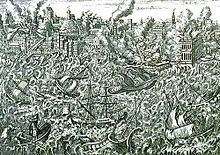 1755 copper engraving showing Lisbon in flames and a tsunami overwhelming the ships in the harbor after the 1755 Lisbon earthquake.
1755 copper engraving showing Lisbon in flames and a tsunami overwhelming the ships in the harbor after the 1755 Lisbon earthquake.
Disaster fell upon Portugal in the morning of 1 November 1755, when Lisbon was struck by a violent earthquake with an estimated Richter scale magnitude of 9. The city was razed to the ground by the earthquake and the subsequent tsunami and ensuing fires.[18] Sebastião de Melo survived by a stroke of luck and then immediately embarked on rebuilding the city, with his famous quote: "What now? We bury the dead and feed the living."
Despite the calamity and huge death toll, Lisbon suffered no epidemics and within less than one year was already being rebuilt. The new downtown of Lisbon was designed to resist subsequent earthquakes. Architectural models were built for tests, and the effects of an earthquake were simulated by marching troops around the models. The buildings and big squares of the Pombaline Downtown of Lisbon still remain as one of Lisbon's tourist attractions: They represent the world's first quake-proof buildings[citation needed]. Sebastião de Melo also made an important contribution to the study of seismology by designing an inquiry that was sent to every parish in the country.
Following the earthquake, Joseph I gave his Prime Minister even more power, and Sebastião de Melo became a powerful, progressive dictator. As his power grew, his enemies increased in number, and bitter disputes with the high nobility became frequent. In 1758 Joseph I was wounded in an attempted assassination. The Távora family and the Duke of Aveiro were implicated and executed after a quick trial. The Jesuits were expelled from the country and their assets confiscated by the crown. Sebastião de Melo showed no mercy and prosecuted every person involved, even women and children. This was the final stroke that broke the power of the aristocracy and ensured the victory of the Minister against his enemies. Based upon his swift resolve, Joseph I made his loyal minister Count of Oeiras in 1759.
In 1762 Spain invaded Portuguese territory as part of the Seven Years' War, however by 1763 the status-quo between Spain and Portugal before the war had been restored.
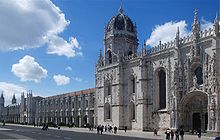 The Jerónimos Monastery, Lisbon, is one of the most prominent monuments of the Manueline-style architecture. It was declared a UNESCO World Heritage Site in 1983, along with the nearby Tower of Belém.
The Jerónimos Monastery, Lisbon, is one of the most prominent monuments of the Manueline-style architecture. It was declared a UNESCO World Heritage Site in 1983, along with the nearby Tower of Belém.
Following the Távora affair, the new Count of Oeiras knew no opposition. Made "Marquis of Pombal" in 1770, he effectively ruled Portugal until Joseph I's death in 1779. However, historians also argue that Pombal’s "enlightenment," while far-reaching, was primarily a mechanism for enhancing autocracy at the expense of individual liberty and especially an apparatus for crushing opposition, suppressing criticism, and furthering colonial economic exploitation as well as intensifying book censorship and consolidating personal control and profit.[19]
The new ruler, Queen Maria I of Portugal, disliked the Marquis because of the power he amassed, and never forgave him for the ruthlessness at which he dispatched the Távora family, and upon her accession to the throne, she did what she had long vowed to do: she withdrew all his political offices. Pombal died peacefully on his estate at Pombal in 1782.
In the autumn of 1807, Napoleon moved French troops through Spain to invade Portugal. From 1807 to 1811, British-Portuguese forces would successfully fight against the French invasion of Portugal, while the royal family and the Portuguese nobility, including Maria I, relocated to the Portuguese territory of Brazil, at that time a colony of the Portuguese Empire, in South America. This episode is known as the Transfer of the Portuguese Court to Brazil.
Brazilian independence
Main articles: Colonial Brazil, Peninsular War, Transfer of the Portuguese Court to Brazil, Liberal Revolution of 1820, and Brazilian Independence Brazil just before independence in 1822 – Cisplatina (modern Uruguay) was one of the last additions to the territory of Brazil under Portuguese rule.
Brazil just before independence in 1822 – Cisplatina (modern Uruguay) was one of the last additions to the territory of Brazil under Portuguese rule.
Portugal began a slow but inexorable decline until the 20th century. This decline was hastened by the independence in 1822 of the country's largest colonial possession, Brazil. In 1807, as Napoleon Bonaparte's army closed in on Portugal's capital city of Lisbon, the Prince Regent João VI of Portugal transferred his court to Brazil and established Rio de Janeiro as the capital of the Portuguese Empire. In 1815, the Portuguese Empire changed its name to the United Kingdom of Portugal, Brazil and the Algarves.
Due to the change in its status and the arrival of the Portuguese royal family, Brazilian administrative, civic, economical, military, educational, and scientific apparatus were expanded and highly modernized. Portuguese and their allied British troops fought against the French Invasion of Portugal and by 1815 the situation in Europe had cooled down sufficiently that João VI would be able to safely return to Lisbon. However, the King of Portugal remained in Brazil until the Liberal Revolution of 1820, which started in Porto, demanded his return to Lisbon in 1821.
Thus he returned to Portugal but left his son Pedro in charge of Brazil. When the king attempted the following year to return the Kingdom of Brazil to subordinate status as a principality, his son Pedro, with the overwhelming support of the Brazilian elites, declared Brazil's independence from Portugal. Cisplatina (today's sovereign state of Uruguay), in the south, was one of the last additions to the territory of Brazil under Portuguese rule.
Colonial Portuguese Africa
Main articles: Angola (Portugal), Cape Verde, Mozambique (Portugal), Portuguese Guinea, Ouidah, and São Tomé and Príncipe The Pink Map project: Portugal's claim of sovereingty over the lands between Portuguese Angola and Portuguese Mozambique.
The Pink Map project: Portugal's claim of sovereingty over the lands between Portuguese Angola and Portuguese Mozambique.
At the height of European colonialism in the 19th century, Portugal had already lost its territory in South America and all but a few bases in Asia. Luanda, Benguela, Bissau, Lourenço Marques, Porto Amboim and the Island of Mozambique were among the oldest Portuguese-founded port cities in its African territories. During this phase, Portuguese colonialism focused on expanding its outposts in Africa into nation-sized territories to compete with other European powers there.
With the Conference of Berlin of 1884, Portuguese Africa territories had their borders formally established on request of Portugal in order to protect the centuries-long Portuguese interests in the continent from rivalries enticed by the Scramble for Africa. Portuguese Africa's cities and towns like Nova Lisboa, Sá da Bandeira, Silva Porto, Malanje, Tete, Vila Junqueiro, Vila Pery and Vila Cabral were founded or redeveloped inland during this period and beyond. New coastal towns like Beira, Moçâmedes, Lobito, João Belo, Nacala and Porto Amélia, were also founded. Even before the turn of the century, railway tracks as the Benguela railway in Angola, and the Beira railway in Mozambique, started to be built to link coastal areas and selected inland regions.
Other episodes during this period of the Portuguese presence in Africa include the 1890 British Ultimatum. This forced the Portuguese military to retreat from the land between the Portuguese colonies of Mozambique and Angola (most of present-day Zimbabwe and Zambia), which had been claimed by Portugal and included in its "Pink Map," which clashed with British aspirations to create a Cape to Cairo Railway. The Portuguese territories in Africa were Cape Verde, São Tomé and Príncipe, Portuguese Guinea, Angola, and Mozambique. The tiny fortress of São João Baptista de Ajudá on the coast of Dahomey, was also under Portuguese rule. In addition, the country still ruled the Asian territories of Portuguese India, Portuguese Timor and Macau.
Republic
Main articles: Lisbon Regicide, 5 October 1910 revolution, Portuguese First Republic, and Estado Novo (Portugal) Manuel II, the last King of Portugal.
Manuel II, the last King of Portugal.
On 1 February 1908, the king Carlos I of Portugal and his heir apparent, Prince Luis Filipe, were murdered in Lisbon. Under his rule, Portugal was twice declared bankrupt – on 14 June 1892, and again on 10 May 1902 – causing social turmoil, economic disturbances, protests, revolts and criticism of the monarchy. Manuel II of Portugal become the new king, but was eventually overthrown by the 5 October 1910 revolution, which abolished the regime and instated republicanism in Portugal. Political instability and economic weaknesses were fertile ground for chaos and unrest during the Portuguese First Republic, which aggravated by the Portuguese military intervention in World War I, led to a military coup d'état in 1926 and the creation of the National Dictatorship (Ditadura Nacional).
This in turn led to the establishment of the right-wing dictatorship of the Estado Novo under António de Oliveira Salazar in 1933. Portugal was one of only five European countries to remain neutral in World War II. From the 1940s to the 1960s, Portugal was a founding member of NATO, OECD and the European Free Trade Association (EFTA). Gradually, new economic development projects and relocation of white mainland Portuguese citizens into the overseas colonies in Africa were initiated, with Angola and Mozambique, as the largest and richest overseas territories, being the main targets of those initiatives.
End of colonialism
Main articles: Portuguese Colonial War and Movimento das Forças ArmadasMap of the Portuguese Overseas provinces in Africa by the time of the Portuguese Colonial War (1961–1974).
After India attained independence in 1947, the residents of Dadra and Nagar Haveli, with the support of the Indian government and the help of pro-independence organisations, liberated the territories of Dadra and Nagar Haveli from Portuguese rule in 1954.[20] In 1961, São João Baptista de Ajudá's annexation by the Republic of Dahomey was the start of a process that led to the final dissolution of the centuries-old Portuguese Empire. According to the census of 1921 São João Baptista de Ajudá had 5 inhabitants and, at the moment of the ultimatum by the Dahomey Government, it had only 2 inhabitants representing Portuguese Sovereignty. Another forcible retreat from overseas territories occurred in December 1961 when Portugal refused to relinquish the territories of Goa, Daman and Diu. As a result, the Portuguese army and navy were involved in armed conflict in its colony of Portuguese India against the Indian Armed Forces. The operations resulted in the defeat of the Portuguese defensive garrison, which was forced to surrender. The outcome was the loss of the remaining Portuguese territories in the Indian subcontinent.
Also in the early 1960s, independence movements in the Portuguese overseas provinces of Angola, Mozambique and Guinea in Africa, resulted in the Portuguese Colonial War (1961–1974).
Carnation Revolution
Main article: Carnation RevolutionThroughout the colonial war period Portugal had to deal with increasing dissent, arms embargoes and other punitive sanctions imposed by most of the international community. However, the authoritarian and conservative Estado Novo regime, firstly installed and governed by António de Oliveira Salazar and from 1968 onwards led by Marcelo Caetano, tried to preserve a vast centuries-long intercontinental empire with a total area of 2,168,071 km2.[21] The Portuguese government and army successfully resisted the decolonization of its overseas territories until April 1974, when a bloodless left-wing military coup in Lisbon, known as the Carnation Revolution, led the way for the independence of the overseas territories in Africa and Asia, as well as for the restoration of democracy after two years of a transitional period known as PREC (Processo Revolucionário Em Curso, or On-Going Revolutionary Process). This period was characterized by social turmoil and power disputes between left- and right-wing political forces. Some factions, including Álvaro Cunhal's Partido Comunista Português (PCP), unsuccessfully tried to turn the country into a communist state. The retreat from the overseas territories and the acceptance of its independence terms by Portuguese head representatives for overseas negotiations, which would create newly-independent communist states in 1975 (most notably the People's Republic of Angola and the People's Republic of Mozambique), prompted a mass exodus of Portuguese citizens from Portugal's African territories (mostly from Portuguese Angola and Mozambique).[22][23]
Over a million destitute Portuguese refugees fled the former Portuguese colonies. Mário Soares and António de Almeida Santos were charged with organising the independence of Portugal's overseas territories. By 1975, all the Portuguese African territories were independent and Portugal held its first democratic elections in 50 years. However, the country continued to be governed by a military-civilian provisional administration until the Portuguese legislative election of 1976 that took place on 25 April, exactly one year after the previous election, and two years after the Carnation Revolution. With a new Constitution approved, the country's main aim was economic recovery and strengthening of the nation's democracy. It was won by the Portuguese Socialist Party (PS) and Mário Soares, its leader, became Prime Minister of the 1st Constitutional Government on 23 July. In the following years, Portugal's economic situation obliged the government to pursue International Monetary Fund (IMF)-monitored stabilization programs in 1977–78 and 1983–85.
European integration
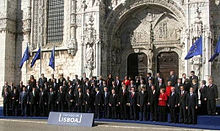 The Treaty of Lisbon was signed by the European Union member states on 13 December 2007 in the Jerónimos Monastery, Lisbon
The Treaty of Lisbon was signed by the European Union member states on 13 December 2007 in the Jerónimos Monastery, Lisbon
In 1986, Portugal joined the European Economic Community (EEC) that later became the European Union (EU). In the following years Portugal's economy progressed considerably as result of EEC/EU structural and cohesion funds and Portuguese companies' easier access to foreign markets. Portugal's last overseas territory, Macau, was not handed over to the People's Republic of China (PRC) until 1999, under the 1987 joint declaration that set the terms for Macau's handover from Portugal to the PRC. In 2002, the independence of East Timor (Asia) was formally recognized by Portugal, after an incomplete decolonization process that was started in 1975 because of the Carnation Revolution.
On 26 March 1995, Portugal started to implement Schengen Area rules, eliminating border controls with other Schengen members while simultaneously strengthening border controls with non-member states. In 1996 the country was a co-founder of the Community of Portuguese Language Countries (CPLP) headquartered in Lisbon. Expo '98 took place in Portugal and in 1999 it was one of the founding countries of the euro and the Eurozone.
On 5 July 2004, José Manuel Barroso, then Prime Minister of Portugal, was nominated President of the European Commission, the most powerful office in the European Union. On 1 December 2009, the Treaty of Lisbon entered into force, after had been signed by the European Union member states on 13 December 2007 in the Jerónimos Monastery, in Lisbon, enhancing the efficiency and democratic legitimacy of the Union and improving the coherence of its action.
Economic disruption in the wake of the late-2000s financial crisis led the country to negotiate in 2011 with the IMF and the European Union, through the European Financial Stability Mechanism (EFSM) and the European Financial Stability Facility (EFSF), a loan to help the country stabilise its finances.
Geography
Main articles: Geography of Portugal and Protected areas of PortugalThe blue-green lakes of the Lagoa das Sete Cidades within the Sete Cidades Massif on the island of São Miguel, Azores.
 A view of Serra da Estrela, the highest range on the mainland.
A view of Serra da Estrela, the highest range on the mainland.
The territory of Portugal includes an area in the Iberian Peninsula (referred to as the continent by most Portuguese) and two archipelagos in the Atlantic Ocean: the archipelagos of Madeira and the Azores. It lies between latitudes 32° and 43° N, and longitudes 32° and 6° W.
Mainland Portugal is split by its main river, the Tagus that flows from Spain and disgorges in Tagus Estuary, before escaping into the Atlantic. The northern landscape is mountainous towards the interior with several plateaus indented by river valleys, whereas the south, that includes the Algarve and the Alentejo regions, is characterized by rolling plains.
Portugal's highest peak is the similarly named Mount Pico on the island of Pico in the Azores. This ancient volcano, which measures 2,351 m (7,713 ft) is a highly iconic symbol of the Azores, while the Serra da Estrela on the mainland (the summit being 1,991 m (6,532 ft) above sea level) is an important seasonal attraction for skiers and winter sports enthusiasts.
The archipelagos of Madeira and the Azores are scattered within the Atlantic Ocean: the Azores straddling the Mid-Atlantic Ridge on a tectonic triple junction, and Madeira along a range formed by in-plate hotspot geology (much like the Hawaiian Islands). Geologically, these islands were formed by volcanic and seismic events, although the last terrestrial volcanic eruption occurred in 1957–58 (Capelinhos) and minor earthquakes occur sporadically, usually of low intensity.
Portugal's Exclusive Economic Zone, a sea zone over which the Portuguese have special rights over the exploration and use of marine resources, has 1,727,408 km2. This is the 3rd largest Exclusive Economic Zone of the European Union and the 11th largest in the world.
Climate
Portugal is defined as a Mediterranean climate (Csa in the south and Douro region, and Csb in the north and western Alentejo), and also Semi-arid climate or Steppe climate (Bsk in certain parts of Beja district) according to the Koppen-Geiger Climate Classification), and is one of the warmest European countries: the annual average temperature in mainland Portugal varies from 13 °C (55.4 °F) in the mountainous interior north to over 18 °C (64.4 °F) in the south and on the Guadiana river basin. The Algarve, separated from the Alentejo region by mountains reaching up to 900 metres in Pico da Foia, has a climate similar to that of the southern coastal areas of Spain.
Annual average rainfall in the mainland varies from just over 3,000 mm (118.1 in) in the northern mountains to less than 300 mm (11.8 in) in the area of the Massueime River, near Côa, along the Douro river. Mount Pico is recognized as receiving the largest annual rainfall (over6,250 mm (246.1 in) per year) in Portugal, according to Instituto de Meteorologia (English: Portuguese Meteorological Institute).[24]
In some areas, such as the Guadiana basin, annual average temperatures can be as high as 20 °C (68 °F), but summer temperatures may be over 45 °C (113 °F) (as a study from the Archeological Park in Côa determined).[25] In the high mountains, such as Peneda-Gerês National Park, a temperate maritime climate permeates (Cfb, according to Koppen-Geiger). The record high of 47.4 °C (117.3 °F) was recorded in Amareleja (although this is not the hottest spot in summer, according to satellite readings).[26]
Snowfalls occur regularly in the interior North and Center of the country in particular in the districts of Vila Real, Bragança, Viseu and Guarda. In winter temperatures may drop below −10 °C (14.0 °F) in particular in Serra da Estrela, Serra do Gerês and Serra de Montesinho. In these places snow can fall any time from October to May. In the south of the country snowfalls are rare but still occur in the highest elevations.
The country has around 2500 to 3200 hours of sunshine a year, an average of 4–6 h in winter and 10–12 h in the summer, with higher values in the southeast and lower in the northwest. The sea surface temperature on the west coast of mainland Portugal varies from 13 °C (55.4 °F)-15 °C (59.0 °F) in winter to 18 °C (64.4 °F)-20 °C (68.0 °F) in the summer while on the south coast in the summer the water temperature is typically around 22 °C (71.6 °F) occasionally reaching 25 °C (77.0 °F).
Both the archipelagos of the Azores and Madeira have a subtropical climate, although variations between islands exist, making weather predictions very difficult (owing to topography, temperature and humidity). The Madeiran and Azorean archipelagos have a narrower temperature range, with annual average temperatures exceeding 20 °C (68 °F) along the coast (according to the Portuguese Meteorological Institute). Some islands in Azores do have drier months in the summer. Consequently, the island of the Azores have been identified as having a Mediterranean climate (both Csa and Csb types), while some islands (such as Flores or Corvo) are classified as Maritime Temperate (Cfb) or Humid subtropical (Cfa), respectively, according to Koppen-Geiger classification. Porto Santo island in Madeira has a semi-arid Steppe climate (BSh). The Savage Islands, which are part of the regional territory of Madeira are unique in being classified as a Desert climates (BWh) with an annual average rainfall of approximately 150 mm (5.9 in). The sea surface temperature in the archipelagos varies from 16 °C (60.8 °F)-18 °C (64.4 °F) in winter to 23 °C (73.4 °F)-25 °C (77.0 °F) in the summer occasionally reaching 26 °C (78.8 °F).
In the southern Azores, and still within the Portuguese maritime territory, there is a unique area of tropical climate (as defined by Koppen-Geiger) influenced by Gulf Stream where sea surface temperatures are over 20 °C (68 °F) even during the winter (Source AEMET).
Biodiversity
Owing to humans occupying the territory of Portugal for thousands of years, little is left of the original vegetation. Protected areas of Portugal include one national park (Portuguese: Parque Nacional), 12 natural parks (Portuguese: Parque Natural), nine natural reserves (Portuguese: Reserva Natural), five natural monuments (Portuguese: Monumento Natural), and seven protected landscapes (Portuguese: Paisagem Protegida), which include the Parque Nacional da Peneda-Gerês, the Parque Natural da Serra da Estrela and the Paul de Arzila. These natural environments are shaped by diverse flora, and include widespread species of pine (especially the Pinus pinaster and Pinus pinea species), the chestnut (Castanea sativa), the cork-oak (Quercus suber), the holm oak (Quercus ilex), the Portuguese oak (Quercus faginea), and eucalyptus (Eucalyptus globulus). All are prized for their economic value. Laurissilva is a unique type of subtropical rainforest found in few areas of Europe and the world: in the Azores, and in particular on the island of Madeira, there are large forests of endemic Laurasilva forests (the latter protected as a natural heritage preserve).
There are several species of diverse mammalian fauna, including the fox, badger, Iberian lynx, Iberian Wolf, wild goat (Capra pyrenaica), wild cat (Felis silvestris), hare, weasel, polecat, chameleon, mongoose, civet, brown bear[citation needed] (spotted near Rio Minho, close to Peneda-Gerês) and many others. Portugal is an important stopover for migratory birds, in places such as Cape St. Vincent or the Monchique mountain, where thousands of birds cross from Europe to Africa during the autumn or in the spring (return migration). Most of the avian species congregate along the Iberian Peninsula since it is the closest stopover between northern Europe and Africa. Six hundred bird species make their nests in Portugal (either permanently or during the course of migration), and annually there are new registries of nesting species. The archipelagos of the Azores and Madeira are transient stopover for American, European, and African birds, while continental Portugal mostly encounters European and African bird species.
There are over 100 varieties of freshwater fish species, varying from the giant European catfish (in the Tagus International Natural Park) to some small and endemic species that live only in small lakes (along the western lakes for example). Some of these rare and specific species are highly endangered because of habitat loss, pollution and drought. Upwelling along the west coast of Portugal makes the sea extremely rich in nutrients and diverse species of marine fish; the Portuguese marine waters are one of the richest in the world. Marine fish species are more common, and include thousands of species, such as the sardine (Sardina pilchardus), tuna and Atlantic mackerel. Bioluminescent species are also well-represented (including species in different colour spectrum and forms), like the glowing plankton that are possible to observe in some beaches.
There are many endemic insect species, most only found in certain parts of Portugal, while other species are more widespread like the stag beetle (Lucanus cervus) and the cicada. The Macronesian islands (Azores and Madeira) have many endemic species (like birds, reptiles, bats, insects, snails and slugs) that evolved independent from other regions of Portugal. In Madeira, for example, it is possible to observe more than 250 species of land gastropods.
Governance
Main articles: Government of Portugal and Politics of Portugal Aníbal Cavaco Silva is the current President of the Portuguese Republic.
Aníbal Cavaco Silva is the current President of the Portuguese Republic.
Portugal has been a democratic republic since the ratification of the Constitution of 1976, with Lisbon, the nation's largest city, as its capital. The constitution grants the division, or separation, of powers among legislative, executive, and judicial branches. The four main institutions as described in this constitution are the President of the Republic, the Parliament, known as the Assembleia da República (English: Assembly of the Republic), the Government, headed by a Prime Minister, and the courts.
The President, who is elected to a five-year term, has a supervisory non-executive role: the current President is Aníbal Cavaco Silva. The Parliament is a chamber composed of 230 deputies elected for a four-year term. The government, whose head is the Prime Minister (currently Pedro Passos Coelho), chooses a Council of Ministers, that comprises the Ministers and State Secretaries. The courts are organized into several levels: judicial, administrative, and fiscal branches. The Supreme Courts are institutions of last resort/appeal. A thirteen-member Constitutional Court oversees the constitutionality of the laws.
Portugal operates a multi-party system of competitive legislatures/local administrative governments at the national-, regional- and local-levels. The Legislative Assembly, Regional Assemblies and local municipalities and/or parishes, are dominated by two political parties, the Socialist Party and the Social Democratic Party, in addition to the Unitarian Democratic Coalition (Portuguese Communist Party plus Ecologist Party "The Greens"), the Left Bloc and the Democratic and Social Centre – People's Party, which garner between 5 and 15% of the vote regularly.
Executive branch
The President, elected to a five-year term by direct, universal suffrage, is also Commander-in-Chief of the Armed Forces. Presidential powers include the appointment of the Prime Minister and Council of Ministers (where the President is obligated by the results from Legislative Elections); dismissing the Prime Minister; dissolving the Assembly (to call early elections); vetoing legislation (which may be overridden by the Assembly); and declaring a State of War or siege.
The President is advised on issues of importance by the Council of State, which is composed of six senior civilian officers, any former Presidents elected under the 1976 Constitution, five-members chosen by the Assembly, and five selected by the president.
The Government is headed by the presidentially-appointed Prime Minister, who names a Council of Ministers to act as the government and cabinet. Each government is required to define the broad outline of its policies in a program, and present it to the Assembly for a mandatory period of debate. The failure of the Assembly to reject the program by a majority of deputies confirms the government in office.
Legislative branch
The Assembly of the Republic is a unicameral body composed of up to 230 deputies. Elected by universal suffrage according to a system of proportional representation, deputies serve four-year terms of office, unless the President dissolves the Assembly and calls for new elections.
Law and criminal justice
The Portuguese legal system is part of the civil law legal system, also called the continental family legal system. Until the end of the 19th century, French law was the main influence. Since then, the major influence has been German law. The main laws include the Constitution (1976, as amended), the Civil Code (1966, as amended) and the Penal Code (1982, as amended). Other relevant laws are the Commercial Code (1888, as amended) and the Civil Procedure Code (1961, as amended).
Portuguese law applied in the former colonies and territories and continues to be the major influence for those countries. Portugal's main police organizations are the Guarda Nacional Republicana – GNR (National Republican Guard), a gendarmerie; the Polícia de Segurança Pública – PSP (Public Security Police), a civilian police force who work in urban areas; and the Polícia Judiciária – PJ (Judicial Police), a highly specialized criminal investigation police that is overseen by the Public Ministry.
Portugal was one of the first countries in the world to abolish the death penalty. Maximum jail sentences are limited to 25 years.
Portugal has arguably the most liberal laws concerning possession of illicit drugs in the Western world. In 2001 Portugal decriminalized possession of effectively all drugs that are still illegal in other developed nations including, but not limited to, marijuana, cocaine, heroin, and LSD. While possession is legal, trafficking and possession of more than "10 days worth of personal use" are still punishable by jail time and fines. People caught with small amounts of any drug are given the choice to go to a rehab facility, and may refuse treatment without consequences. Despite criticism from other European nations, who stated Portugal's drug consumption would tremendously increase, overall drug use rose only slightly, whilst use among teenagers dropped, along with the number of HIV infection cases, which had dropped 50% by 2009.[27][28]
On 31 May 2010, Portugal became the sixth country in Europe and the eighth country in the world to legally recognize same-sex marriage on the national level. The law came into force on 5 June 2010.[29]
Administrative divisions
Main article: Administrative divisions of PortugalAdministratively, Portugal is divided into 308 municipalities (Portuguese: municípios or concelhos), which are subdivided into 4260 civil parishes (Portuguese: freguesia). Operationally, the municipality and civil parish, along with the national government, are the only legally identifiable local administrative units identified by the government of Portugal (for example, cities, towns or villages have no standing in law, although may be used as catchment for the defining services). For statistical purposes the Portuguese government also identifies NUTS, inter-municipal communities and informally, the district system, used until European integration (and being phased-out by the national government). Continental Portugal is agglomerated into 18 districts, while the archipelagos of the Azores and Madeira are governed as autonomous regions; the largest units, established since 1976, are either mainland Portugal (Portuguese: Portugal Continental) and the autonomous regions of Portugal (Azores and Madeira).
The 18 districts of mainland Portugal are: Aveiro, Beja, Braga, Bragança, Castelo Branco, Coimbra, Évora, Faro, Guarda, Leiria, Lisbon, Portalegre, Porto, Santarém, Setúbal, Viana do Castelo, Vila Real and Viseu – each district takes the name of the district capital.
Within the European Union NUTS (Nomenclature of Territorial Units for Statistics) system, Portugal is divided into seven regions: the Azores, Alentejo, Algarve, Centro, Lisboa, Madeira and Norte, and with the exception of the Azores and Madeira, these NUTS areas are subdivided into 28 subregions.
Districts[30] District Area Population District Area Population 1 Lisbon 2,761 km2 2,244,984 
10 Guarda 5,518 km2 160,931 2 Leiria 3,517 km2 (1,358 sq mi) 470,765 11 Coimbra 3,947 km2 429,714 3 Santarém 6,747 km2 (2,605 sq mi) 454,456 12 Aveiro 2,808 km2 714,351 4 Setúbal 5,064 km2 (1,955 sq mi) 849,842 13 Viseu 5,007 km2 378,166 5 Beja 10,225 km2 (3,948 sq mi) 152,706 14 Bragança 6,608 km2 136,459 6 Faro 4,960 km2 (1,915 sq mi) 450,484 15 Vila Real 4,328 km2 207,184 7 Évora 7,393 km2 167,434 16 Porto 2,395 km2 1,816,045 8 Portalegre 6,065 km2 118,952 17 Braga 2,673 km2 848,444 9 Castelo Branco 6,675 km2 195,949 18 Viana do Castelo 2,255 km2 244,947 Autonomous Regions Autonomous Region Area Population Demonym Azores 2,333 km2246,102Azorean Madeira 801 km2267,938Madeiran Foreign relations
Main articles: Foreign relations of Portugal and Portuguese Armed ForcesThe disputed territory of Olivença
A member state of the United Nations since 1955, Portugal is also a founding member of NATO (1949), OECD (1961) and EFTA (1960); it left the latter in 1986 to join the European Economic Community, that would become the European Union in 1993. In 1996 it co-founded the Community of Portuguese Language Countries (CPLP), which seeks to foster closer economic and cultural ties between the world's Lusophone nations.
In addition, Portugal is a full member of the Latin Union (1983) and the Organization of Ibero-American States (1949). It has a friendship alliance and dual citizenship treaty with its former colony, Brazil. Portugal and England (subsequently, the United Kingdom of Great Britain and Northern Ireland) share the world's oldest active military accord through their Anglo-Portuguese Alliance (Treaty of Windsor), which was signed in 1373.
The only international dispute concerns the municipality of Olivença (Olivenza). Under Portuguese sovereignty since 1297, the municipality of Olivenza was ceded to Spain under the Treaty of Badajoz in 1801, after the War of the Oranges. Portugal claimed it back in 1815 under the Treaty of Vienna. However, since the 19th century, it has been continuously and peacefully ruled by Spain which considers the territory not only de facto but also de jure as an integral part of Spain.
Military
Main article: Portuguese Armed ForcesThe armed forces have three branches: Navy, Army and Air Force. They serve primarily as a self-defense force whose mission is to protect the territorial integrity of the country and providing humanitarian assistance and security at home and abroad. As of 2008, the three branches numbered 39,000 active personnel including 6,500 women. Portuguese military expenditure in 2009 was $5.2 billion, representing 2.1 percent of GDP. Military conscription was abolished in 2004. The minimum age for voluntary recruitment is 18 years.
The Army (21,000 personnel) comprises three brigades and other small units. An infantry brigade (mainly equipped with Pandur II APC), a mechanized brigade (mainly equipped with Leopard 2 A6 tanks and M113 APC) and a Rapid Reaction Brigade (consisting of paratroopers, commandos and rangers). The Navy (10,700 personnel, of which 1,580 are marines) has five frigates, two submarines, and 28 patrol and auxiliary vessels. The Air Force (7,500 personnel) has the Lockheed F-16 Fighting Falcon as the main combat aircraft.
In addition to the three branches of the armed forces, there is the Republican National Guard, a security force subject to military law and organization (gendarmerie) comprising 25,000 personnel. This force is under the authority of both the Defense and the Interior Ministry. It has provided detachments for participation in international operations in Iraq and East Timor.
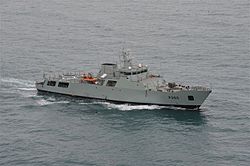 Portuguese-built Viana do Castelo class patrol vessel.
Portuguese-built Viana do Castelo class patrol vessel.
The United States maintains a military presence with 770 troops in the Lajes Air Base at Terceira Island, in the Azores. The Allied Joint Force Command Lisbon (JFC Lisbon) – one of the three main subdivisions of NATO's Allied Command Operations – it is based in Oeiras, near Lisbon.
In the 20th century, Portugal engaged in two major military interventions: World War I and the Portuguese Colonial War (1961–1974). After the end of the Portuguese Empire in 1975, the Portuguese Armed Forces have participated in peacekeeping missions in East Timor, Bosnia, Kosovo, Afghanistan, Somalia, Iraq (Nasiriyah) and Lebanon. Portugal also conducted several independent unilateral military operations abroad, as were the cases of the interventions of the Portuguese Armed Forces in Angola in 1992 and in Guinea-Bissau in 1998 with the main objectives of protecting and withdrawing of Portuguese and foreign citizens threatened by local civil conflits.
Economy
Main articles: Economy of Portugal and Economic history of PortugalSince the Carnation Revolution (1974) which culminated with the end of one of its most notable phases of economic expansion (that started in the 1960s),[31] there has been a significant change in annual economic growth. After the turmoil of the 1974 revolution and the PREC period, Portugal has been trying to adapt itself to a changing modern global economy. Since the 1990s, Portugal's economic development model has been slowly changing from one based on public consumption to one focused on exports, private investment, and development of the high-tech sector. Business services have overtaken more traditional industries such as textiles, clothing, footwear, cork (of which Portugal is the world's leading producer),[32] wood products and beverages.[33]
Most industry, business and finance are concentrated in Lisbon and Porto metropolitan areas. The districts of Aveiro, Braga, Coimbra, and Leiria are the biggest economic centres outside those two main metropolitan areas.
The Portuguese currency is the euro (€) and the country's economy is in the Eurozone since its starting. Portugal's central bank is the Banco de Portugal, which is an integral part of the European System of Central Banks.
Sectors
Primary sector
Most of Portugal's farms have a small area devoted to a diversified intensive farming, like these in the Oeste subregion.
Agriculture in Portugal is based on small to medium-sized family-owned dispersed units. However, the sector also includes larger scale intensive farming export-oriented agrobusinesses backed by companies (like Grupo RAR's Vitacress, Sovena, Lactogal, Vale da Rosa, Companhia das Lezírias and Valouro). The country produces a wide variety of crops and livestock products, including green vegetables, rice, corn, barley, olives, oilseeds, nuts, cherries, bilberry, table grapes, edible mushrooms, dairy products, poultry and beef. Forestry has also played an important economic role among the rural communities and industry (namely paper industry that includes Portucel Soporcel Group, engineered wood that includes Sonae Indústria, and furniture that includes several manufacturing plants in and around Paços de Ferreira, the core of Portugal's major industrial operations of IKEA). In 2001, the gross agricultural product accounted for 4% of the national GDP.
Traditionally a sea-power, Portugal has had a strong tradition in the Portuguese fishing sector and is one of the countries with the highest fish consumption per capita.[34] The main landing sites in Portugal (including Azores and Madeira), according to total landings in weight by year, are the harbours of Matosinhos, Peniche, Olhão, Sesimbra, Figueira da Foz, Sines, Portimão and Madeira. Portuguese processed fish products are exported through several companies under a number of different brands like Conservas Ramirez, the World’s oldest canned fish producer still in operation, as well as Combate, Comur, General, Líder, Maná, Murtosa, Pescador, Pitéu, Tenório, Torreira, Vasco da Gama, etc.
Secondary sector
Industry is diversified, ranging from automobile (Volkswagen Autoeuropa, Peugeot Citroen), aerospace (Embraer), electronics and textiles, to food, chemicals, cement and wood pulp. Volkswagen Group's AutoEuropa motor vehicle assembly plant in Palmela is among the largest foreign direct investment projects in Portugal.
Modern non-traditional technology-based industries like aerospace, biotechnology and information technology, have been developed in several locations across the country. Alverca, Covilhã,[35] Évora,[36] and Ponte de Sor are the main centres of Portuguese aerospace industry, which is led by Brazil-based company Embraer and the Portuguese company OGMA. Since after the turn of the 21st century, many major biotechnology and information technology industries have been founded and are concentrated in the metropolitan areas of Lisbon, Porto, Braga, Coimbra and Aveiro.
Tertiary sector
Travel and tourism continues to become extremely important for Portugal, with visitor numbers forecast to increase significantly over the next years. However, there is increasing competition from Eastern European destinations such as Croatia who offer similar attractions, which are often cheaper. Consequently, the country is almost obligated to focus on its niche attractions such as health, nature and rural tourism in order to stay ahead of its competitors.[37]
The banking and insurance sectors performed well until the late-2000s financial crisis, partly reflecting a rapid deepening of the market in Portugal. While sensitive to various types of market and underwriting risks, both the life and non-life sectors, overall, are estimated to be able to withstand a number of severe shocks, even though the impact on individual insurers varies widely.[38]
State-owned companies
Major State-owned companies include Águas de Portugal (water), ANA (airports), Caixa Geral de Depósitos (banking), Comboios de Portugal (railways), Companhia das Lezírias (agriculture), CTT (postal services), RTP (media) and TAP Portugal (airline). Some of the former are managed by state-run holding company Parpública, which is a shareholder of several companies, both public and private.
Listed companies
Companies listed on Euronext Lisbon stock exchange like EDP, Cimpor, Corticeira Amorim, Galp, Jerónimo Martins, Millennium bcp, Portucel Soporcel, Portugal Telecom and Sonae, are among the largest corporations of Portugal by number of employees, net income or international market share. The Euronext Lisbon is the major stock exchange of Portugal and is part of the NYSE Euronext, the first global stock exchange. The PSI-20 is Portugal's most selective and widely known stock index.
Performance
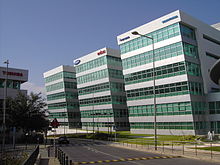 Oeiras Municipality, in Lisbon Metropolitan Area, is home of many of the headquarters of multinational companies operating in Portugal
Oeiras Municipality, in Lisbon Metropolitan Area, is home of many of the headquarters of multinational companies operating in Portugal
The Global Competitiveness Report for 2005, published by the World Economic Forum, placed Portugal's competitiveness in the 22nd position, but the 2008–2009 edition placed Portugal in the 43rd position out of 134 countries and territories.[39] Research about quality of life by the Economist Intelligence Unit's quality of life survey placed Portugal as the country with the 19th-best quality of life in the world for 2005, ahead of other economically and technologically advanced countries like France, Germany, the United Kingdom and South Korea, but 9 places behind its only neighbour, Spain.[40] This is despite the fact that Portugal remains the country with the lowest per capita GDP in Western Europe.[41]
The poor performance of the Portuguese economy was explored in April 2007 by The Economist, which described Portugal as "a new sick man of Europe".[42] From 2002 to 2007, the unemployment rate increased by 65% (270,500 unemployed citizens in 2002, 448,600 unemployed citizens in 2007).[43] By early December 2009, unemployment had reached 10.2% – a 23-year record high. In December 2009, ratings agency Standard and Poor's lowered its long-term credit assessment of Portugal to "negative" from "stable," voicing pessimism on the country's structural weaknesses in the economy and weak competitiveness that would hamper growth and the capacity to strengthen its public finances and reduce debt.[44] In July 2011, ratings agency Moody's downgraded its long-term credit assessment of Portugal after warning of deteriorating risk of default in March 2011.[45]
Corruption has become an issue of major political and economic significance for the country. Some cases are well known and were widely reported in the media, such as the affairs in several municipalities involving local town hall officials and businesspersons, as well as a number of politicians with wider responsibilities and power.[46][47] Nevertheless the Transparency International report for 2010 places Portugal in 31st position in terms of perceived corruption, just below Israel and Spain, and 34 positions above Italy.[48]
A report published in January 2011 by the Diário de Notícias, a leading Portuguese newspaper, demonstrated that in the period between the Carnation Revolution in 1974 and 2010, the democratic Portuguese Republic governments encouraged over expenditure and investment bubbles through unclear public-private partnerships. This funded numerous ineffective and unnecessary external consultancy and advising committees and firms, allowed considerable slippage in state-managed public works, inflated top management and head officers' bonuses and wages, causing a persistent and lasting recruitment policy that boosted the number of redundant public servants. The economy was also damaged by risky credit, public debt creation and mismanaged European structural and cohesion funds for almost four decades. Apparently, the Prime Minister Sócrates's cabinet was not able to forecast or prevent any of this when symptoms first appeared in 2005, and in 2011 the country was on the verge of bankruptcy.[49]
If analysed under a wider time span, the convergence of the Portuguese economy to EU levels has been impressive, especially from 1986 to the early 2000s.[50][51] According to Barry (2003), "what appears to have been crucial in the Portuguese case, relative to Spain at least, is the degree of labour-market flexibility that the economy exhibits. (...) Thus Portuguese convergence has been impressive, even though, consistent with its relatively low human-capital stock, the economy has specialised in low-tech production."[51]
On April 6, 2011 Prime Minister José Sócrates announced on national television that the country would request financial assistance from the IMF and the European Financial Stability Facility, like Greece and the Republic of Ireland had done before. It was the third time that external financial aid was requested to the IMF – the first was in the late 1970s following the Carnation Revolution.
In October 2011, Moody's Analytics downgraded nine Portuguese banks, blaming financial weakness.[52]
Labour market
Although a developed country and a high income country, Portugal has the lowest GDP per capita in Western Europe and its population has one of the lowest incomes per head among member states of the European Union. According to Eurostat, in 2009, Portugal's GDP per capita stood at 80% of the EU27 average,[53] the 10th lowest in the Union.
The average wage in Portugal is 1,039 € per month (net),[54] and the minimum wage, which is regulated by law, is €485 per month (although paid in 14 installments, which means that on average the minimum wage is 565 euros). Officially, in 2008 the unemployment rate decreased to 7.3% in the second quarter of 2008.[55] However, it immediately rose again to higher rates. Influenced by events worldwide, by December 2009, unemployment had surpassed the 10% mark nationwide, by 2010, it was about 11%, and in 2011 it was above 12%.
Tourism
Main article: Tourism in PortugalThe Pena National Palace in Sintra is a UNESCO World Heritage Site and one of Portugal's most visited landmarks
Portugal is among the 20 most visited countries in the world, receiving an average of 13 million foreign tourists each year.[56] Tourism is playing an increasingly important role in Portugal's economy, contributing to about 5% of its Gross Domestic Product (GDP).[citation needed]
Tourist hotspots in Portugal are Lisbon, the Algarve and Madeira, but the Portuguese government continues to promote and develop new tourist destinations, such as the Douro Valley, the island of Porto Santo, and Alentejo. Lisbon is, after Barcelona, the European city which attracts the most tourists (with seven million tourists occupying the city's hotels in 2006, a number that grew 11.8% compared to previous year).[57] Lisbon in recent years surpassed the Algarve as the leading tourist region in Portugal. Porto and Northern Portugal, especially the urban areas north of Douro River valley, was the tourist destination which grew most (11.9%) in 2006, surpassing Madeira (in 2010), as the third most visited destination.[citation needed]
Most tourists in Portugal are British-, Spanish- or German-origin visitors, travel by low cost airliners, and not only seek sun and beaches, but increasingly search for cultural, gastronomic, environmental or nautical experiences (or travel for reasons of business).[citation needed]
Tourist regions
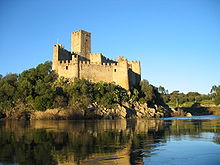 Almourol Castle, a Knights Templar stronghold used during the Christian Reconquista of Iberia from the Muslim Moors
Almourol Castle, a Knights Templar stronghold used during the Christian Reconquista of Iberia from the Muslim Moors
The main tourist regions can be broken-down into (by order of importance): the Greater Lisbon (Portuguese: Lisboa), the Algarve, Greater Porto and Northern Portugal (Portuguese: Porto and Norte), the Portuguese Islands (Portuguese: Ilhas Portuguesas: Madeira and Azores), and Alentejo. Other tourist regions include Douro Sul, Templários, Dão-Lafões, Costa do Sol, Costa Azul, Planície Dourada, that are unknown to many tourists or visitors.[citation needed]
Most of these regions are grouped in tourism reference areas, which continue to be in a state of reorganization and evolution, some based on the traditional regions of Portugal: the Costa Verde (Green Coast); Costa da Prata (Silver Coast)); Costa de Lisboa (Lisbon Coast); Montanhas (Mountains); Planícies (Plains); Algarve; and the islands of the archipelagos of Madeira and the Azores.[citation needed]
Transport
Main articles: Transport in Portugal and Rail transport in PortugalBy the early 1970s Portugal's fast economic growth with increasing consumption and purchase of new automobiles set the priority for improvements in transportation. Again in the 1990s, after joining the European Economic Community, the country built many new motorways. Today, the country has a 68,732 km (42,708 mi) road network, of which almost 3,000 km (1,864 mi) are part of system of 44 motorways. Opened in 1944, the first motorway (which linked Lisbon to the National Stadium) was an innovative project that made Portugal among one of the first countries in the world to establish a motorway (this roadway eventually became the Lisbon-Cascais highway, or A5). But, although a few other tracts were created (around 1960 and 1970), it was only after the beginning of the 1980s that large-scale motorway construction was implemented. In 1972, Brisa, the highway concessionaire, was founded to handle the management of many of the regions motorways.
Vasco da Gama bridge is the longest bridge in Europe.[60][61]
Continental Portugal's 89,015 km2 (34,369 sq mi) territory is serviced by three international airports located near the principal cities of Lisbon, Porto and Faro. Lisbon's geographical position makes it a stopover for many foreign airlines at several airports within the country. The primary flag-carrier is TAP Portugal, although many other domestic airlines provide services within and without the country. The government decided to build a new airport outside Lisbon, in Alcochete, to replace Lisbon Portela Airport. Currently, the most important airports are in Lisbon, Faro, Porto, Funchal (Madeira), and Ponta Delgada (Azores), managed by the national airport authority group ANA – Aeroportos de Portugal.
A national railway system that extends throughout the continent and into Spain, is supported and administered by Comboios de Portugal. Rail transport of passengers and goods is derived using the 2,791 km (1,734 mi) of railway lines currently in service, of which 1,430 km (889 mi) are electrified and about 900 km (559 mi) allow train speeds greater than 120 km/h (75 mph). The railway network is managed by the REFER while the transport of passengers and goods are the responsibility of Caminhos de Ferro Portugueses (CP), both public companies. In 2006 the CP carried 133 million passengers and 9,750,000 t (9,600,000 long tons; 10,700,000 short tons) of goods.
The major seaports are located in Leixões, Aveiro, Figueira da Foz, Lisbon, Setúbal, Sines and Faro.
The two largest metropolitan areas have subway systems: Lisbon Metro and Metro Sul do Tejo in the Lisbon Metropolitan Area and Porto Metro in the Porto Metropolitan Area, each with more than 35 km (22 mi) of lines. In Portugal, Lisbon tram services have been supplied by the Companhia de Carris de Ferro de Lisboa (Carris), for over a century. In Porto, a tram network, of which only a tourist line on the shores of the Douro remain, began construction on 12 September 1895 (a first for the Iberian Peninsula). All major cities and towns have their own local urban transport network, as well as taxi services.
Science and technology
 The headquarters (rectorate) of the University of Porto (UP) – UP is the largest Portuguese university by both number of students and research output.
The headquarters (rectorate) of the University of Porto (UP) – UP is the largest Portuguese university by both number of students and research output. Main article: Science and technology in Portugal
Main article: Science and technology in PortugalScientific and technological research activities in Portugal are mainly conducted within a network of R&D units belonging to public universities and state-managed autonomous research institutions like the INETI – Instituto Nacional de Engenharia, Tecnologia e Inovação and the INRB – Instituto Nacional dos Recursos Biológicos. The funding and management of this research system is mainly conducted under the authority of the Ministry of Science, Technology and Higher Education (MCTES) itself and the MCTES's Fundação para a Ciência e Tecnologia (FCT). The largest R&D units of the public universities by volume of research grants and peer-reviewed publications, include biosciences research institutions like the Instituto de Medicina Molecular, the Centre for Neuroscience and Cell Biology, the IPATIMUP, the Instituto de Biologia Molecular e Celular and the Abel Salazar Biomedical Sciences Institute.
 António Egas Moniz was a Portuguese neurologist awarded with the Nobel Prize in Physiology or Medicine in 1949.
António Egas Moniz was a Portuguese neurologist awarded with the Nobel Prize in Physiology or Medicine in 1949.
Among the largest non-state-run research institutions in Portugal are the Instituto Gulbenkian de Ciência and the Champalimaud Foundation, a neuroscience and oncology research centre, which in addition awards every year one of the highest monetary prizes of any science prize in the world. A number of both national and multinational high-tech and industrial companies, are also responsible for research and development projects. One of the oldest learned societies of Portugal is the Sciences Academy of Lisbon, founded in 1779.
Iberian bilateral state-supported research efforts include the International Iberian Nanotechnology Laboratory and the Ibercivis distributed computing platform, which are joint research programmes of both Portugal and Spain. Portugal is a member of several pan-European scientific organizations. These include the European Space Agency (ESA), the European Laboratory for Particle Physics (CERN), ITER, and the European Southern Observatory (ESO).
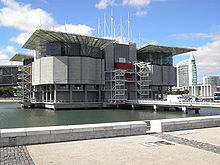 The Lisbon Oceanarium - by the time of its opening, it was among the largest aquariums in the world.
The Lisbon Oceanarium - by the time of its opening, it was among the largest aquariums in the world.
Portugal has the largest aquarium in Europe, the Lisbon Oceanarium, and the Portuguese have several other notable organizations focused on science-related exhibits and divulgation, like the state agency Ciência Viva, a programme of the Portuguese Ministry of Science and Technology to the promotion of a scientific and technological culture among the Portuguese population,[62] the Science Museum of the University of Coimbra, the National Museum of Natural History at the University of Lisbon, and the Visionarium.
With the emergence and growth of several science parks throughout the world that helped create many thousands of scientific, technological and knowledge-based businesses, Portugal started to develop several[63] science parks across the country. These include the Taguspark (in Oeiras), the Coimbra iParque (in Coimbra), the biocant (in Cantanhede), the Madeira Tecnopolo[64] (in Funchal), Sines Tecnopolo[65] (in Sines), Tecmaia[66] (in Maia) and Parkurbis[67] (in Covilhã). Companies locate in the Portuguese science parks to take advantage of a variety of services ranging from financial and legal advice through to marketing and technological support.
Egas Moniz, a Portuguese physician who developed the cerebral angiography and leucotomy, received in 1949 the Nobel Prize in Physiology or Medicine – he is the first Portuguese recipient of a Nobel Prize and the only in the sciences.
The European Innovation Scoreboard 2011, placed Portugal-based innovation in the 15th position, with an impressive increase in innovation expenditure and output.[68]
Energy
Main article: Renewable energy in PortugalAlqueva Dam, in the Alentejo; the Alqueva project, an irrigation and hydroelectric power generation system, created the largest artificial lake in Western Europe.
Portugal has considerable resources of wind and river power, the two most cost-effective renewable sources. Since the 2000s, there has been a trend towards the development of a renewable resource industry and reduction of both consumption and use of fossil fuel resources. In 2006, the world's largest solar power plant at that date, the Moura Photovoltaic Power Station, began operating near Moura, in the south, while the world's first commercial wave power farm, the Aguçadoura Wave Farm, opened in the Norte region (2008). By the end of 2006, 66% of the country's electrical production was from coal and fuel power plants, while 29% were derived from hydroelectric dams, and 6% by wind energy.[69]
In 2008, renewable energy resource methods began to produce 43% of the nation's consumption of electricity, even as hydroelectric production decreased due to severe droughts.[70] As of June 2010, electricity exports had outnumbered imports. In the period between January and May 2010, 70% of the national production of energy came from renewable sources.[71]
Portugal’s national energy transmission company, Redes Energéticas Nacionais (REN), uses sophisticated modeling to predict weather, especially wind patterns, and computer programs to calculate energy from the various renewable-energy plants. Before the solar/wind revolution, Portugal had generated electricity from hydropower plants on its rivers for decades. But new programs combine wind and water: wind-driven turbines pump water uphill at night, the most blustery period; then the water flows downhill by day, generating electricity, when consumer demand is highest. Portugal’s distribution system is also now a two-way street. Instead of just delivering electricity, it draws electricity from even the smallest generators, like rooftop solar panels. The government aggressively encouraged such contributions by setting a premium price for those who buy rooftop-generated solar electricity.
Demographics
The Instituto Nacional de Estatística (Portuguese: National Institute of Statistics) estimates that, according to the 2011 census, the population was 10,555,853 (of which 52% was female, 48% was male). This population has been relatively homogeneous for most of its history: a single religion (Catholicism) and a single language have contributed to this ethnic and national unity, namely after the expulsion of the Moors, Moriscos and Sephardi Jews.[72]
Native Portuguese are an Iberian ethnic group, whose ancestry is very similar to other Western and Southern Europeans and Mediterranean peoples, in particular Spaniards, with whom they share a common ancestry, history and cultural proximity.
The most important demographic influence in the modern Portuguese seems to be the oldest one; current interpretation of Y-chromosome and mtDNA data suggests that the Portuguese have their origin in Paleolithic peoples that began arriving to the European continent around 45,000 years ago.[citation needed] All subsequent migrations did leave an impact, genetically and culturally, but the main population source of the Portuguese is still Paleolithic.[citation needed]
Urbanization
There are two Greater Metropolitan Areas (GAMs): Lisbon and Porto.[73]
Rank City name Population Metro
AreaPopulation[74] Subregion Population 1 Lisbon 564,657 Lisbon 2,661,850 Grande Lisboa 2,003,580 2 Vila Nova de Gaia 302,092 Porto – Grande Porto – 3 Porto 263,131 Porto 1,679,854 Grande Porto 1,572,176 4 Braga 181,819 Minho 814,083 Cávado 410,608 5 Amadora 175,872 Lisbon – Grande Lisboa – 6 Almada 101,500 Lisbon – Península de Setúbal – 7 Coimbra 101,069 Coimbra 435,900 Baixo Mondego 340,342 8 Funchal 100,526 n/a[75] n/a Madeira 245,806 9 Setúbal 89,303 Lisbon – Península de Setúbal 714,589 10 Agualva-Cacém 81,845 Lisbon – Grande Lisboa – Immigration
Main article: Immigration to PortugalPortugal's colonial history has long since been a cornerstone of its national identity, as has its geographic position at the southwestern corner of Europe, looking out into the Atlantic Ocean. It was the last western colonial European powers to give up its overseas territories (among them Angola and Mozambique in 1975), turning over the administration of Macau to the People's Republic of China at the end of 1999. Consequently, it has both influenced and been influenced by cultures from former colonies or dependencies, resulting in immigration from these former territories for both economic and/or personal reasons. Portugal, long a country of emigration (the vast majority of Brazilians have some Portuguese ancestry),[76] has now become a country of net immigration,[77] and not just from the last Indian (Portuguese until 1961), African (Portuguese until 1975), and Far East Asian (Portuguese until 1999) overseas territories. An estimated 800,000 Portuguese returned to Portugal as the country's African possessions gained independence in 1975.[76] By 2007, Portugal had 10,617,575 inhabitants of whom about 332,137 were legal immigrants.[1]
Since the 1990s, along with a boom in construction, several new waves of Ukrainian, Brazilian, people from the former Portuguese colonies in Africa and other Africans have settled in the country. Romanians, Moldovans and Chinese have also chosen Portugal as destination. Portugal's Romani population, estimated at about 40,000,[78] offers another element of ethnic diversity. Most Romanis congregate with similar ethnic groups in the southern parts of the country and sell clothing and handicrafts in rural markets.
In addition, a number of EU citizens, mostly from the United Kingdom, northern European or Nordic countries, have become permanent residents in the country (with the British community being mostly composed of retired pensioners and choosing to live in the Algarve and Madeira).[79]
Religion
Main article: Religion in PortugalThe Sanctuary of Our Lady of Fátima, the largest Marian shrine.
Today, 84.5% of the Portuguese population are Roman Catholic while 2.2% follow other Christian faiths.[80] Some 9% of the population are self-declared as non-religious (Zuckerman 2005). In addition, the country has small Protestant, Mormon, Muslim, Hindu, Sikh, Christian Orthodox, Jehovah's Witnesses, Baha'i, Buddhist and Jewish communities.
Many Portuguese holidays, festivals and traditions have a Christian origin or connotation. Although relations between the Portuguese state and the Roman Catholic Church were generally amiable and stable since the earliest years of the Portuguese nation, their relative power fluctuated. In the 13th and 14th centuries, the church enjoyed both riches and power stemming from its role in the reconquest, its close identification with early Portuguese nationalism and the foundation of the Portuguese educational system, including the first university. The growth of the Portuguese overseas empire made its missionaries important agents of colonization, with important roles in the education and evangelization of people from all the inhabited continents. The growth of liberal and nascent republican movements during the eras leading to the formation of the First Portuguese Republic (1910–26) changed the role and importance of organized religion.
Portugal is a secular state: church and state were formally separated during the Portuguese First Republic, and later reiterated in the 1976 Portuguese Constitution. Other than the Constitution, the two most important documents relating to religious freedom in Portugal are: the 1940 Concordata (later amended in 1971) between Portugal and the Holy See, and the 2001 Religious Freedom Act.
Languages
Main articles: Languages of Portugal, Portuguese language, Mirandese language, and Portuguese-based creole languagesPortuguese is the official language of Portugal. Portuguese is a Romance language that originated in what is now Galicia (Spain) and Northern Portugal, from the Galician-Portuguese language. It is derived from the Latin spoken by the romanized Pre-Roman peoples of the Iberian Peninsula around 2000 years ago. In the 15th and 16th centuries, it spread worldwide as Portugal established a colonial and commercial empire (1415–1999).
As a result, nowadays the Portuguese language is also official and spoken in Brazil, Angola, Mozambique, Cape Verde, São Tomé and Príncipe, Guinea-Bissau, and East Timor. These countries, plus Macau Special Administrative Region (People's Republic of China), make up the Lusosphere, term derived from the ancient Roman province of Lusitania, which currently matches the Portuguese territory south of the Douro river. Mirandese is also recognized as a co-official regional language in some municipalities of northeastern Portugal. It retains fewer than 5,000 speakers in Portugal (a number that can be up to 12,000 if counting second language speakers).[citation needed]
Education
Main articles: Education in Portugal and Higher education in Portugal Headquarters of the New University of Lisbon.
Headquarters of the New University of Lisbon.
The educational system is divided into preschool (for those under age 6), basic education (9 years, in three stages, compulsory), secondary education (3 years, till the 12th grade), and higher education (university and polytechnic).
Total adult literacy rate is 99%. Portuguese primary school enrollments are close to 100%. According to the OECD's Programme for International Student Assessment (PISA) 2009, the average Portuguese 15-years old student, when rated in terms of reading literacy, mathematics and science knowledge, is placed at the same level as those students from the United States, Sweden, Germany, Ireland, France, Denmark, United Kingdom, Hungary and Taipei, with 489 points (493 is the average).[81] Over 35% of college-age citizens (20 years old) attend one of the country's higher education institutions[82] (compared with 50% in the United States and 35% in the OECD countries). In addition to being a key destination for international students, Portugal is also among the top places of origin for international students. All higher education students, both domestic and international, totaled 380,937 in 2005.
 The tower of the University of Coimbra, Coimbra – the university is one of the oldest in continuous operation in the world.
The tower of the University of Coimbra, Coimbra – the university is one of the oldest in continuous operation in the world.
Portuguese universities have existed since 1290. The oldest Portuguese university was first established in Lisbon before moving to Coimbra. Historically, within the scope of the Portuguese Empire, the Portuguese founded in 1792 the oldest engineering school of Latin America (the Real Academia de Artilharia, Fortificação e Desenho), as well as the oldest medical college of Asia (the Escola Médico-Cirúrgica de Goa) in 1842. The largest university in Portugal is the University of Porto. Universities are usually organized into faculties. Institutes and schools are also common designations for autonomous subdivisions of Portuguese higher education institutions. The Bologna process has been adopted since 2006 by Portuguese universities and polytechnical institutes. Higher education in state-run educational establishments is provided on a competitive basis, a system of numerus clausus is enforced through a national database on student admissions. However, every higher education institution offers also a number of additional vacant places through other extraordinary admission processes for sportsmen, mature applicants (over 23 years old), international students, foreign students from the Lusosphere, degree owners from other institutions, students from other institutions (academic transfer), former students (readmission), and course change, which are subject to specific standards and regulations set by each institution or course department. Most student costs are supported with public money. However, with the increasing tuition fees a student has to pay to attend a Portuguese state-run higher education institution and the attraction of new types of students (many as part time students or in evening classes) like employees, businessmen, parents, and pensioners, many departments make a substantial profit from every additional student enrolled in courses, with benefits for the college or university's gross tuition revenue and without loss of educational quality (teacher per student, computer per student, classroom size per student, etc).
Portugal has entered into cooperation agreements with MIT (US) and other North American institutions to further develop and increase the effectiveness of Portuguese higher education and research.
Health
Main article: Health in Portugal Hospital of Santa Maria, Lisbon.
Hospital of Santa Maria, Lisbon.
According to the latest Human Development Report, the average Life Expectancy in 2011 was 79.5 years.
The Portuguese health system is characterized by three coexisting systems: the National Health Service (NHS), special social health insurance schemes for certain professions (health subsystems) and voluntary private health insurance. The NHS provides universal coverage. In addition, about 25% of the population is covered by the health subsystems, 10% by private insurance schemes and another 7% by mutual funds.
The Ministry of Health is responsible for developing health policy as well as managing the NHS. Five regional health administrations are in charge of implementing the national health policy objectives, developing guidelines and protocols and supervising health care delivery. Decentralization efforts have aimed at shifting financial and management responsibility to the regional level. In practice, however, the autonomy of regional health administrations over budget setting and spending has been limited to primary care.
The NHS is predominantly funded through general taxation. Employer (including the state) and employee contributions represent the main funding sources of the health subsystems. In addition, direct payments by the patient and voluntary health insurance premiums account for a large proportion of funding.
Similar to the other Eur-A countries, most Portuguese die from noncommunicable diseases. Mortality from cardiovascular diseases (CVD) is higher than in the Eurozone, but its two main components, ischaemic heart disease and cerebrovascular disease, display inverse trends compared with the Eur-A, with cerebrovascular disease being the single biggest killer in Portugal (17%). Portuguese people die 12% less often from cancer than in the Eur-A, but mortality is not declining as rapidly as in the Eur-A. Cancer is more frequent among children as well as among women younger than 44 years. Although lung cancer (slowly increasing among women) and breast cancer (decreasing rapidly) are scarcer, cancer of the cervix and the prostate are more frequent. Portugal has the highest mortality rate for diabetes in the Eur-A, with a sharp increase since the late 1980s.
Portugal's infant mortality rate has dropped sharply since the 1980s, when 24 of 1000 newborns died in the first year of life. It is now around 3 deaths per a 1000 newborns. This improvement was mainly due to the decrease in neonatal mortality, from 15.5 to 3.4 per 1000 live births.
People are usually well informed about their health status, the positive and negative effects of their behaviour on their health and their use of health care services. Yet their perceptions of their health can differ from what administrative and examination-based data show about levels of illness within populations. Thus, survey results based on self-reporting at the household level complement other data on health status and the use of services. Only one third of adults rated their health as good or very good in Portugal (Kasmel et al., 2004). This is the lowest of the Eur-A countries reporting and reflects the relatively adverse situation of the country in terms of mortality and selected morbidity.[83]
Culture
Main article: Culture of Portugal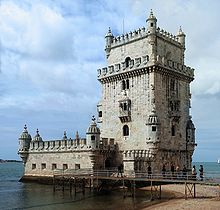 Belém Tower, Lisbon. A UNESCO World Heritage Site and a typical example of Portugal's unique Manueline architecture.
Belém Tower, Lisbon. A UNESCO World Heritage Site and a typical example of Portugal's unique Manueline architecture.
Portugal has developed a specific culture while being influenced by various civilizations that have crossed the Mediterranean and the European continent, or were introduced when it played an active role during the Age of Discovery. In the 1990s and 2000s, Portugal modernized its public cultural facilities, in addition to the Calouste Gulbenkian Foundation established in 1956 in Lisbon. These include the Belém Cultural Center in Lisbon, Serralves Foundation and the Casa da Música, both in Porto, as well as new public cultural facilities like municipal libraries and concert halls that were built or renovated in many municipalities across the country.
Architecture
Main article: Architecture of PortugalTraditional architecture is distinctive and include the Manueline, also known as Portuguese late Gothic, a sumptuous, composite Portuguese style of architectural ornamentation of the first decades of the 16th century, incorporating maritime elements and representations of the Portuguese Age of Discovery. Modern Portugal has given the world renowned architects like Eduardo Souto de Moura, Álvaro Siza Vieira (both Pritzker Prize winners) and Gonçalo Byrne. In Portugal Tomás Taveira is also noteworthy, particularly due to stadium design.[84][85][86]
Cinema
Main article: Cinema of PortugalPortuguese cinema has a long tradition, reaching back to the birth of the medium in the late 19th century. Portuguese film directors such as Arthur Duarte, António Lopes Ribeiro, Pedro Costa, Manoel de Oliveira, António-Pedro Vasconcelos, João César Monteiro, João Botelho and Leonel Vieira, are among those that gained notability. Noted Portuguese film actors include Joaquim de Almeida, Daniela Ruah, Maria de Medeiros, Diogo Infante, Soraia Chaves, Vasco Santana, Ribeirinho, and António Silva, among many others
Literature
Main article: Portuguese literature Luís de Camões, Portuguese poet of the 16th century.
Luís de Camões, Portuguese poet of the 16th century.
Portuguese literature, one of the earliest Western literatures, developed through text and song. Until 1350, the Portuguese-Galician troubadours spread their literary influence to most of the Iberian Peninsula.[87] Gil Vicente (ca. 1465 – ca. 1536), was one of the founders of both Portuguese and Spanish dramatic traditions.
Adventurer and poet Luís de Camões (ca. 1524–1580) wrote the epic poem "Os Lusíadas" (The Lusiads), with Virgil's Aeneid as his main influence. Modern Portuguese poetry is rooted in neoclassic and contemporary styles, as exemplified by Fernando Pessoa (1888–1935). Modern Portuguese literature is represented by authors such as Almeida Garrett, Camilo Castelo Branco, Eça de Queiroz, Sophia de Mello Breyner Andresen, António Lobo Antunes and Miguel Torga. Particularly popular and distinguished is José Saramago, winner of the 1998 Nobel Prize for literature.
Cuisine
Main articles: Portuguese Cuisine and Portuguese WinePortuguese cuisine is diverse. The Portuguese consume a lot of dry cod (bacalhau in Portuguese), for which there are hundreds of recipes. There are more than enough bacalhau dishes for each day of the year. Two other popular fish recipes are grilled sardines and caldeirada, a potato-based stew that can be made from several types of fish. Typical Portuguese meat recipes, that may be made out of beef, pork, lamb, or chicken, include cozido à portuguesa, feijoada, frango de churrasco, leitão (roast suckling pig) and carne de porco à alentejana, a very popular northern dish is the arroz de sarrabulho (rice stewed in pigs blood) or the arroz de cabidela (Rice and chickens meat stewed in chickens blood).
Typical fast food dishes include the francesinha from Porto, and bifanas (grilled pork) or prego (grilled beef) sandwiches, which are well known around the country. The Portuguese art of pastry has its origins in Middle-Ages Catholic monasteries widely spread across the country. These monasteries, using very few ingredients (mostly almonds, flour, eggs and some liquor), managed to create a spectacular wide range of different pastries, of which pastéis de Belém (or pastéis de nata) originally from Lisbon, and ovos moles from Aveiro are examples. Portuguese cuisine is very diverse, with different regions having their own traditional dishes. The Portuguese have a culture of good food and throughout the country there are myriad good restaurants and small typical tascas.
Portuguese wines have deserved international recognition since the times of the Roman Empire, which associated Portugal with their god Bacchus. Today the country is known by wine lovers and its wines have won several international prizes. Some of the best Portuguese wines are: Vinho Verde, Vinho Alvarinho, Vinho do Douro, Vinho do Alentejo, Vinho do Dão, Vinho da Bairrada and the sweet: Port Wine, Madeira Wine and the Moscatel from Setúbal and Favaios. Port Wine is well known around the world and the most widely known wine type in the world[citation needed]. The Douro wine region is the oldest in the world[citation needed].
Music
Main article: Music of Portugal The Fado, painting by Portuguese artist José Malhoa (1855–1933).
The Fado, painting by Portuguese artist José Malhoa (1855–1933).
Portuguese music encompasses a wide variety of genres. The most renowned is fado, a melancholy urban music, usually associated with the Portuguese guitar and saudade, or longing. Coimbra fado, a unique type of fado, is also noteworthy. Internationally notable performers include Amália Rodrigues, Carlos Paredes, José Afonso, Mariza, Carlos do Carmo, António Chainho, Mísia, and Madredeus.
In addition to fado and folk, the Portuguese listen to pop and other types of modern music, particularly from North America and the United Kingdom, as well as a wide range of Portuguese and Brazilian artists and bands. Artists with international recognition include Moonspell, Buraka Som Sistema, Blasted Mechanism and The Gift, with the two latter being nominees for a MTV Europe Music Award.
Portugal has several summer music festivals, such as Festival Sudoeste in Zambujeira do Mar, Festival de Paredes de Coura in Paredes de Coura, Festival Vilar de Mouros near Caminha, and Optimus Alive!, Rock in Rio Lisboa and Super Bock Super Rock in Greater Lisbon. Out of the summer season, Portugal has a large number of festivals, designed more to an urban audience, like Flowfest or Hip Hop Porto. Furthermore, one of the largest international Goa trance festivals takes place in central Portugal every two years, the Boom Festival, that is also the only festival in Portugal to win international awards: European Festival Award 2010 - Green'n'Clean Festival of the Year and the Greener Festival Award Outstanding 2008 and 2010. There is also the student festivals of Queima das Fitas are major events in a number of cities across Portugal. In 2005, Portugal held the MTV Europe Music Awards, in Pavilhão Atlântico, Lisbon.
Fandango is one of the most popular regional dances.
In the Classical music domain, Portugal is represented by names as the pianist Artur Pizarro, Maria João Pires, Sequeira Costa, the violinists Gerardo Ribeiro, Carlos Damas, and in the past by the great cellist Guilhermina Suggia. Notable composers include José Vianna da Motta, Carlos Seixas, João Domingos Bomtempo, João de Sousa Carvalho, Luís de Freitas Branco and his student Joly Braga Santos, Fernando Lopes-Graça, Emmanuel Nunes and Sérgio Azevedo.
Painting
It has also a rich history as far as painting is concerned. The first well-known painters date back to the 15th century – like Nuno Gonçalves – were part of the Gothic painting period. José Malhoa, known for his work Fado, and Columbano Bordalo Pinheiro (who painted the portraits of Teófilo Braga and Antero de Quental) were both references in naturalist painting.
The 20th century saw the arrival of Modernism, and along with it came the most prominent Portuguese painters: Amadeo de Souza-Cardoso, who was heavily influenced by French painters, particularly by the Delaunays. Among his best known works is Canção Popular a Russa e o Fígaro. Another great modernist painter/writer was Almada Negreiros, friend to the poet Fernando Pessoa, who painted his (Pessoa's) portrait. He was deeply influenced by both Cubist and Futurist trends. Prominent international figures in visual arts nowadays include painters Vieira da Silva, Júlio Pomar, Helena Almeida, Joana Vasconcelos, Julião Sarmento and Paula Rego.
Sport
Main article: Sport in PortugalFootball (soccer) is the most popular and played sport. There are several football competitions ranging from local amateur to world-class professional level. The legendary Eusébio is still a major symbol of Portuguese football history. FIFA World Player of the Year winners Luís Figo and Cristiano Ronaldo, are among the numerous examples of other world-class football (soccer) players born in Portugal and noted worldwide. Portuguese football managers are also noteworthy, with José Mourinho, André Villas-Boas, Carlos Queiroz and Manuel José among the most renowned.
The Portuguese national teams, have titles in the FIFA World Youth Championship and in the UEFA youth championships. The main national team – Selecção Nacional – finished second in Euro 2004 (held in Portugal), reached the third place in the 1966 FIFA World Cup, and reached the fourth place in the 2006 FIFA World Cup, their best results in major competitions to date.
Futebol Clube do Porto, Sport Lisboa e Benfica, and Sporting Clube de Portugal are the largest sports clubs by popularity and by number of trophies won, often known as "os três grandes" ("the big three"). They have 12 titles won in the European UEFA club competitions, were present in many finals and have been regular contenders in the last stages almost every season. Other than football, many Portuguese sports clubs, including the "big three", compete in several other sports events with a varying level of success and popularity, these may include basketball, futsal, handball, and volleyball.
Portugal has a successful rink hockey team, with 15 world titles and 20 European titles, making it the country with the most wins in both competitions. The most successful Portuguese rink hockey clubs in the history of European championships are Futebol Clube do Porto, Sporting Clube de Portugal, Sport Lisboa e Benfica and Óquei de Barcelos.
The national rugby union team made a dramatic qualification into the 2007 Rugby World Cup and became the first all amateur team to qualify for the World Cup since the dawn of the professional era. The Portuguese national rugby sevens team has performed well, becoming one of the strongest teams in Europe, and proved their status as European champions in several occasions.
In athletics, the Portuguese have won a number of gold, silver and bronze medals in the European, World and Olympic Games competitions. Cycling, with Volta a Portugal being the most important race, is also a popular sports event and include professional cycling teams such as Sport Lisboa e Benfica, Boavista, Clube de Ciclismo de Tavira, and União Ciclista da Maia.
The country has also achieved notable performances in sports like fencing, judo, kitesurf, rowing, sailing, surfing, shooting, triathlon and windsurf, owning several European and world titles. The paralympic athletes have also conquered many medals in sports like swimming, boccia and wrestling.
In motor sport, Portugal is internationally noted for the Rally of Portugal, and the Estoril, Algarve Circuits and the revived Porto Street Circuit which holds a stage of the WTCC every two years, as well as for a number of internationally noted pilots in varied motor sports.
In equestrian sports, Portugal won the only Horseball-Pato World Championship (in 2006), achieved the third position in the First Horseball World Cup (organized in Ponte de Lima, Portugal, in 2008), and has achieved several victories in the European Working Equitation Championship.
In swimming sports, Portugal has two major sports: Swimming and Water Polo.
Northern Portugal has its own original martial art, Jogo do Pau, in which the fighters use staffs to confront one or several opponents.
Other popular sport-related recreational outdoor activities with thousands of enthusiasts nationwide include airsoft, fishing, golf, hiking, hunting and orienteering.
See also
- Outline of Portugal
- Index of Portugal-related articles
References
- Notes
- ^ a b ITDS, Rui Campos, Pedro Senos. "Statistics Portugal". Ine.pt. http://www.ine.pt/xportal/xmain?xpid=INE&xpgid=ine_main. Retrieved 2011-07-02.
- ^ Pordata, "Base de Dados Portugal Contemporâneo". Accessed on March 7, 2011.
- ^ http://www.ine.pt/scripts/flex_v10/Main.html
- ^ a b c d "Portugal". International Monetary Fund. http://www.imf.org/external/pubs/ft/weo/2011/01/weodata/weorept.aspx?sy=2008&ey=2011&scsm=1&ssd=1&sort=country&ds=.&br=1&c=182&s=NGDPD%2CNGDPDPC%2CPPPGDP%2CPPPPC%2CLP&grp=0&a=&pr.x=40&pr.y=5. Retrieved 6 May 2011.
- ^ "Gini Index". Instituto Nacional de Estatística. http://www.ine.pt/xportal/xmain?xpid=INE&xpgid=ine_destaques&DESTAQUESdest_boui=107634627&DESTAQUESmodo=2&xlang=en. Retrieved 14 July 2011.
- ^ "Human Development Report 2010". United Nations. 2010. http://hdr.undp.org/en/media/HDR_2010_EN_Table1.pdf. Retrieved 5 November 2010.
- ^ The Euromosaic study, Mirandese in Portugal[dead link], europa.eu – European Commission website. Retrieved January 2007.
- ^ "Leite de Vasconcelos, José. Cale e Portucale. Opúsculos Vol. V – Etnologia (Parte I) Lisboa, Imprensa Nacional, 1938" (in Portuguese). http://www.instituto-camoes.pt/CVC/bdc/etnologia/opusculos/vol05/opusculos05_28_38.pdf.
- ^ Brian Jenkins, Spyros A. Sofos, "Nation and identity in contemporary Europe", p.145 Routledge, 1996, ISBN 0-415-12313-5
- ^ Melvin Eugene Page, Penny M. Sonnenburg, p. 481
- ^ http://www.visionofhumanity.org/wp-content/uploads/2011/05/2011-GPI-Results-Report-Final.pdf
- ^ Milhazes, José. Os antepassados caucasianos dos portugueses – Rádio e Televisão de Portugal in Portuguese.
- ^ Black Death, Great Moments in Science, ABC Science
- ^ The standard view of historians is that Cabral was blown off course as he was navigating the currents of the South Atlantic, sighted the coast of South America, thereby accidentally discovering Brazil. However, for an alternative account of the discovery of Brazil, see History of Brazil
- ^ Map proves Portuguese discovered Australia: new book, in Reuters (Wed 21 Mar 2007) – (see Theory of Portuguese discovery of Australia)
- ^ http://www.ibge.gov.br/ibgeteen/povoamento/portugueses.html
- ^ Leslie Bethell (1986). "The Cambridge history of Latin America: Colonial Latin America". Cambridge University Press. p.47. ISBN 0-521-24516-8
- ^ "Historical Depictions of the 1755 Lisbon Earthquake"
- ^ Kenneth Maxwell, Pombal, Paradox of the Enlightenment (Cambridge: Cambridge University Press, 1995), 83, 91–108, 160–62.
- ^ P S Lele, Dadra and Nagar Haveli: past and present, Published by Usha P. Lele, 1987,
- ^ "Portugal Não É Um País Pequeno". Purl.pt. http://purl.pt/11440/1/P1.html. Retrieved 2011-02-21.
- ^ Flight from Angola, The Economist (16 August 1975).
- ^ Dismantling the Portuguese Empire, Time Magazine (Monday, 7 July 1975).
- ^ "Instituto de Meteorologia, IP Portugal". Meteo.pt. 2010-01-15. http://www.meteo.pt. Retrieved 27 January 2010.
- ^ [1][dead link]
- ^ "Instituto de Meteorologia, IP Portugal". Meteo.pt. http://www.meteo.pt/pt/oclima/extremos/. Retrieved 22 August 2010.
- ^ http://www.scientificamerican.com/article.cfm?id=portugal-drug-decriminalization
- ^ Maia Szalavitz, Drugs in Portugal: Did Decriminalization Work? , Time (April 26, 2009)
- ^ http://dre.pt/pdf1sdip/2010/05/10500/0185301853.pdf
- ^ "Districts of Portugal". Distritosdeportugal.com. http://www.distritosdeportugal.com/. Retrieved 22 August 2010.
- ^ (Portuguese) Fundação da SEDES – As primeiras motivações, "Nos anos 60 e até 1973 teve lugar, provavelmente, o mais rápido período de crescimento económico da nossa História, traduzido na industrialização, na expansão do turismo, no comércio com a EFTA, no desenvolvimento dos sectores financeiros, investimento estrangeiro e grandes projectos de infra-estruturas. Em consequência, os indicadores de rendimentos e consumo acompanham essa evolução, reforçados ainda pelas remessas de emigrantes.", SEDES
- ^ Grande Enciclopédia Universal, p. 10543, "Portugal", para. 4
- ^ Investing in Portugal Report, Financial Times
- ^ PESSOA, M.F.; MENDES, B.; OLIVEIRA, J.S.. "Culturas marinhas em Portugal" (in Portuguese). http://igbp-portugal.org/cluster2006/comunicacoes/m_f_pessoa/cluster2006-zc06c-comun.pdf. "O consumo médio anual em produtos do mar pela população portuguesa, estima-se em cerca de 58,5 kg/ por habitante sendo, por isso, o maior consumidor em produtos marinhos da Europa e um dos quatro países a nível mundial com uma dieta à base de produtos do mar."[dead link]
- ^ (Portuguese) Aleia vai montar avião até agora vendido em kit e jactos portugueses em 2011, 14 April 2008
- ^ (Portuguese) Évora aprova isenções fiscais aos projectos da Embraer, Diário Digital (22 August 2008)
- ^ "Travel and Tourism in Portugal". Euromonitor.com. http://www.euromonitor.com/Travel_and_Tourism_in_Portugal. Retrieved 2011-07-02.
- ^ Portugal: Financial System Stability Assessment, including Reports on the Observance of Standards and Codes on the following topics: Banking Supervision, Securities Regulation, and Insurance Regulation, IMF, (October 2006)
- ^ "The Global Competitiveness Index rankings". World Economic Forum. http://www.weforum.org/pdf/gcr/2008/rankings.pdf. Retrieved 20 March 2009.
- ^ The Economist. http://www.economist.com/media/pdf/QUALITY_OF_LIFE.pdf.
- ^ (Portuguese)"Portugueses perderam poder de compra entre 2005 e 2007 e estão na cauda da Zona Euro" (in Portuguese). Público. 2008-12-11. http://economia.publico.pt/Noticia/portugueses-perderam-poder-de-compra-entre-2005-e-2007-e-estao-na-cauda-da-zona-euro_1352732. Retrieved 10 October 2010.
- ^ "The Portuguese economy: A new sick man of Europe". The Economist. 2007-04-12. http://www.economist.com/world/europe/displaystory.cfm?story_id=9009032. Retrieved 2011-07-02.
- ^ Luis Miguel Mota, População desempregada aumentou 65% em cinco anos, Destak.pt (6 June 2008)
- ^ Standard and Poor's pessimistic on Portugal, Agence France-Presse (7 December 2009)
- ^ As Portugal Default Risk Climbs, Europe Begins to Stabilize, (29 March 2011)
- ^ Eurojust chief embroiled in Portuguese corruption scandal, euobserver.com (13 May 2009)
- ^ People & Power, Al Jazeera, Al Jazeera (March 2008)
- ^ Transparency International report, Transparency International (2010)
- ^ (Portuguese) Grande investigação DN Conheça o verdadeiro peso do Estado, Diário de Notícias (January 7, 2011)
- ^ http://www.sciencedirect.com/science?_ob=ArticleURL&_udi=B6V97-3VWTCDS-9&_user=499884&_coverDate=11%2F30%2F1996&_rdoc=1&_fmt=high&_orig=gateway&_origin=gateway&_sort=d&_docanchor=&view=c&_acct=C000024499&_version=1&_urlVersion=0&_userid=499884&md5=d36edb1470dfd4db9b46db274f86c7a1&searchtype=a
- ^ a b http://www.tcd.ie/business/staff/fbarry/papers/papers/Regiona_Aid_paper_revised.PDF
- ^ UK financial firms downgraded by Moody's rating agency, BBC (October 7, 2011)
- ^ "Eurostat press release GDP per inhabitant 2009" (in Portuguese). http://epp.eurostat.ec.europa.eu/cache/ITY_PUBLIC/2-15122010-BP/EN/2-15122010-BP-EN.PDF. Retrieved 3 January 2011.
- ^ "Wages and taxes for the Average Joe in the EU 27". http://www.langlophone.com/20100526_edition/20100526_EU27_data_table_flipped.pdf. Retrieved 14 May 2011.
- ^ "Taxa de desemprego desce para 7,3 por cento no segundo trimestre" (in Portuguese). Público. 14 August 2008. http://economia.publico.clix.pt/noticia.aspx?id=1338969.[dead link]
- ^ http://www.unwto.org/facts/eng/pdf/indicators/ITA_top25.pdf
- ^ DN Online, ed (25 January 2007). "Cidades atraem mais turistas do que os destinos sol e mar" (in Portuguese). Lisbon, Portugal: Diário das Noticias. http://www.dn.pt/inicio/interior.aspx?content_id=651813. Retrieved 30 April 2011.
- ^ "ListAfterList.com". ListAfterList.com. http://www.listafterlist.com/tabid/57/listid/7961/Travel++Places/Top+10+Longest+Bridges+in+the+World.aspx. Retrieved 2010-08-22.
- ^ "Curious? Read". Curiousread.com. http://www.curiousread.com/2008/02/ten-longest-bridges-in-world.html. Retrieved 2010-08-22.
- ^ "ListAfterList.com". ListAfterList.com. http://www.listafterlist.com/tabid/57/listid/7961/Travel++Places/Top+10+Longest+Bridges+in+the+World.aspx. Retrieved 22 August 2010.
- ^ "Curious? Read". Curiousread.com. http://www.curiousread.com/2008/02/ten-longest-bridges-in-world.html. Retrieved 22 August 2010.
- ^ "Ciência Viva". Cienciaviva.pt. http://www.cienciaviva.pt/cienciaviva/index.asp?accao=changelang&lang=en. Retrieved 22 August 2010.
- ^ "Tecparques – Associação Portuguesa de Parques de Ciência e Tecnologia". Tecparques.pt. http://www.tecparques.pt/associados.htm. Retrieved 22 August 2010.
- ^ "Madeira Tecnopolo". Madeiratecnopolo.pt. http://www.madeiratecnopolo.pt/. Retrieved 22 August 2010.
- ^ "Sines Tecnopolo". Sines Tecnopolo. http://www.sinestecnopolo.org/. Retrieved 22 August 2010.
- ^ "TECMAIA Parque de Ciência e Tecnologia da Maia". Tecmaia.com.pt. http://www.tecmaia.com.pt. Retrieved 2011-07-02.
- ^ "Parque de Ciência e Tecnologia da Covilhã (Parkurbis)". Parkurbis.pt. http://www.parkurbis.pt/. Retrieved 22 August 2010.
- ^ Portugal ganha terreno no ranking da inovação, Público (February 1, 2011)
- ^ "IEA Energy Statistics: Portugal". International Energy Agency. 2006. http://www.iea.org/Textbase/stats/electricitydata.asp?COUNTRY_CODE=PT. Retrieved 7 April 2009.
- ^ Staff (8 April 2009). "Fontes renováveis originaram 43% da electricidade consumida" (in Portuguese). Diário Digital. http://diariodigital.sapo.pt/news.asp?section_id=114&id_news=381941. Retrieved 17 April 2009.
- ^ Staff (8 June 2010). "Portugal já exportou mais electricidade este ano que em 2009" (in Portuguese). Agência Financeira. http://www.agenciafinanceira.iol.pt/empresas/portugal-agencia-financeira-ren-energia-electricidade/1168567-1728.html?utm_source=feedburner&utm_medium=feed&utm_campaign=Feed:+iol/agenciafinanceira+(agenciafinanceira). Retrieved 8 June 2010.
- ^ "Portugal". The Virtual Jewish History Tour.
- ^ Censos 2011, (Instituto Nacional de Estatística-19 July 2011)
- ^ Source of the city populations: INE census, 2001.
- ^ The Autonomous Region of Madeira is not a Metropolitan Area.
- ^ a b Portugal – Emigration, Eric Solsten, ed. Portugal: A Country Study. Washington: GPO for the Library of Congress, 1993.
- ^ "Portugal sees integration progress", BBC News, 14 November 2005
- ^ A mais discriminada, (Expresso-5 April 2008)
- ^ Brasileiros são a maior colónia estrangeira em Portugal Embaixada de Portugal No Brasil
- ^ "CIA — The World Factbook – Portugal". Cia.gov. https://www.cia.gov/library/publications/the-world-factbook/geos/po.html. Retrieved 2011-02-21.
- ^ "Alunos portugueses pela primeira vez "perto da média" – relatório PISA" (in Portuguese). Destak. http://www.destak.pt/artigo/82223-alunos-portugueses-pela-primeira-vez-perto-da-media-relatorio-pisa.
- ^ "Um Contrato de confiança no Ensino Superior para o futuro de Portugal" (in Portuguese). Government of Portugal, portugal.gov.pt. http://www.portugal.gov.pt/pt/GC18/Governo/Ministerios/MCTES/Intervencoes/Pages/20100111_MCTES_Int_Contrato_Confianca_EnsSup.aspx.
- ^ [2][dead link]
- ^ (Portuguese) Estádios de Tomás Taveira e Souto Moura premiados, Diário de Notícias (July 8, 2005)
- ^ Tomás Taveira, Geoffrey Broadbent (introduction), Publisher: St Martins Pr (February 1991)
- ^ (Portuguese) Tomás Tveira desenha estádio do Palmeiras no Brasil, Diarioeconomico.com
- ^ Poesia e Prosa Medievais, p. 9, para. 4
- Sources
- Bliss, Jorge Braga de; Bliss, C.J. (1990). Unity with Diversity in the European Economy: the Community's Southern Frontier. London, England: Centre for Economic Policy Research. ISBN 978-0-521-39520-5.
- Juang, Noelle Anne (2008). Africa and the Americas: Culture, Politics, and History: A Multidisciplinary Encyclopedia. 2. ISBN 978-1-85109-441-7.
- Page, Penny M. (2003). Colonialism: An International, Social, Cultural, and Political Encyclopedia. 2. ISBN 978-1-57607-335-3.
- Brockey, Liam Matthew (2008). Portuguese Colonial Cities in the Early Modern World. ISBN 978-0-7546-6313-3.
- Ribeiro, Ângelo (2004) (in Portuguese). História de Portugal I — A Formação do Território [History of Portugal: The Formation of the Territory]. QuidNovi. ISBN 989-554-106-6.
- Ribeiro, José Hermano (2004) (in Portuguese). História de Portugal II — A Afirmação do País [History of Portugal II - A Affirmation of Nation]. QuidNovi. ISBN 989-554-107-4.
- de Macedo, José Hermano (2004) (in Portuguese). História de Portugal III — A Epopeia dos Descobrimentos [History of Portugal III - The Epoch of Discoveries]. QuidNovi. ISBN 989-554-108-2.
- de Macedo, José Hermano (2004) (in Portuguese). História de Portugal IV — Glória e Declínio do Império [History of Portugal IV - Glory and Decline of Empire]. QuidNovi. ISBN 989-554-109-0.
- de Macedo, José Hermano (2004) (in Portuguese). História de Portugal V — A Restauração da Indepêndencia [History of Portugal IV - The Restauration of Independence]. QuidNovi. ISBN 989-554-110-4.
- Saraiva, José Hermano (2004) (in Portuguese). História de Portugal X — A Terceira República [History of Portugal X - The Third Republic]. QuidNovi. ISBN 989-554-115-5.
- Loução, Paulo Alexandre (2000) (in Portuguese). Portugal, Terra de Mistérios [Portugal: Land of Mysteries] (3rd ed.). Ésquilo. ISBN 972-8605-04-8.
- Muñoz, Mauricio Pasto (2003) (in Portuguese). Viriato, A Luta pela Liberdade [Viriato: The Struggle for Liberty] (3rd ed.). Ésquilo. ISBN 972-8605-23-4.
- Grande Enciclopédia Universal. Durclub. 2004.
- (in Portuguese) Constituição da República Portuguesa [Constitution of the Portuguese Republic] (VI Revisão Constitucional ed.). 2004.
External links
- Government
- Official Portuguese Government website (English)/(Portuguese)
- Official Parliament website
- Chief of State and Cabinet Members
- General information
- Portugal entry at The World Factbook
- Portugal at UCB Libraries GovPubs
- Portugal at the Open Directory Project
- Portugal in Photography 2007
- National English language newspaper
- Wikimedia Atlas of Portugal
- National Wine Website
- Travel
Coordinates: 38°42′N 9°11′W / 38.7°N 9.183°W
Categories:- Portugal
- Countries bordering the Atlantic Ocean
- European countries
- Liberal democracies
- Portuguese-speaking countries
- Republics
- Member states of the European Union
- Member states of the Union for the Mediterranean
- Member states of NATO
- Member states of the Community of Portuguese Language Countries
- Member states of the United Nations
- Southern Europe
- Western Europe
- Outline of Portugal
Wikimedia Foundation. 2010.



